New support for structure-guided drug discovery coalition research on tropical diseases
Toronto, ON - Almost $2 million is being invested by the Bill & Melinda Gates Foundation to help fight major parasitic diseases of the developing world.
This probe is available from Sigma and Cayman Chemical.
| Probe |
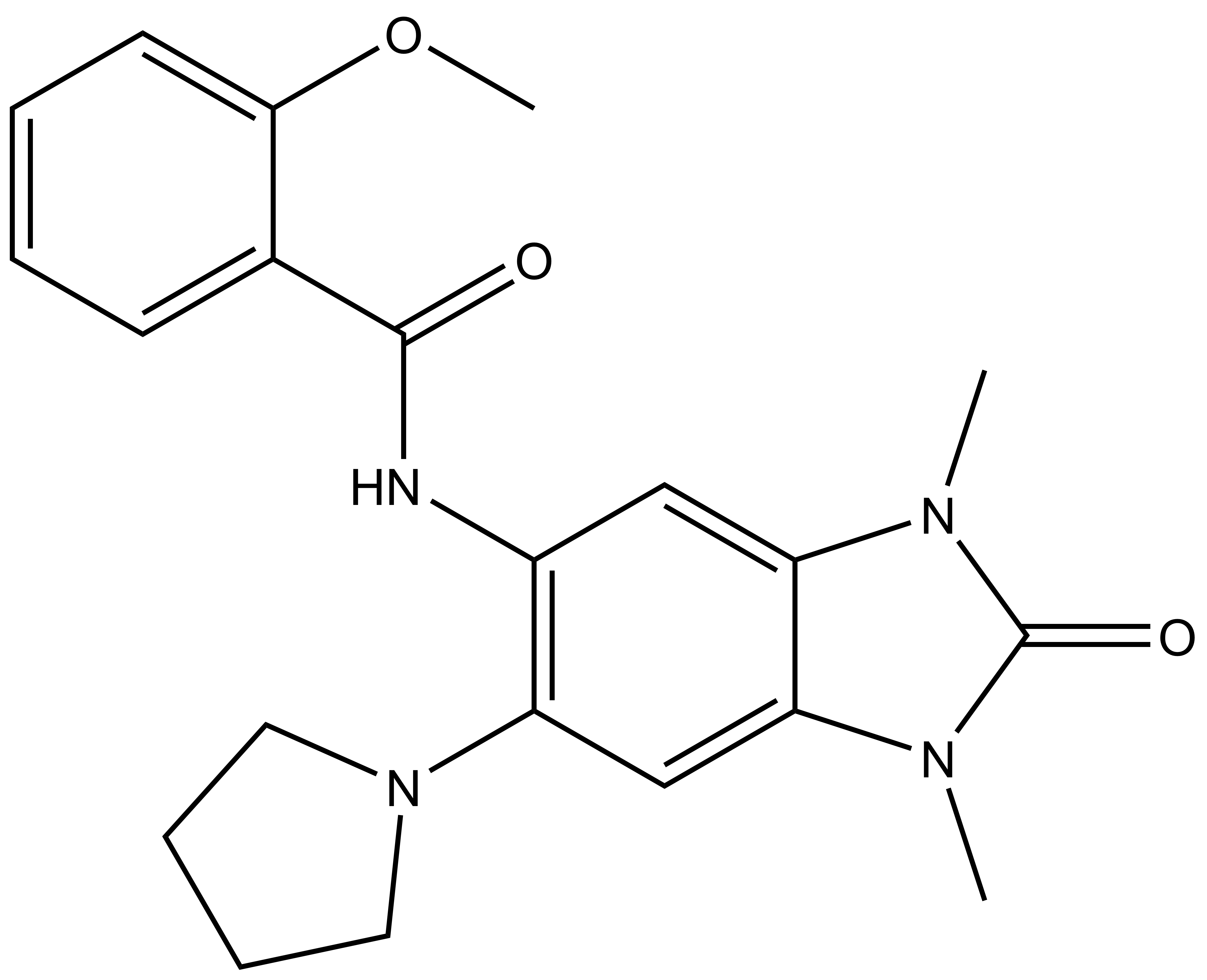 |
PFI-4 |
A chemical probe for the bromodomains of the BRPF (BRomodomain and PHD Finger containing) family of proteins (BRPF1/2/3) has been discovered by the SGC. BRPF1, BRPF2 (BRD1) and BRPF3 are scaffolding proteins, assembling HAT complexes of the MOZ/MORF family (MOZ, Ybf2/Sas3, Sas2, and Tip60) (1). These MYST complexes have a tetrameric core containing BRPF, the tumour suppressor ING and Eaf6/EPC (enhancer of polycomb)-related scaffold subunits. MYST complexes play crucial roles in DNA repair, recombination, and replication as well as in transcription activation (2,3). MOZ is frequently translocated in AML (acute myeloid leukemia) and is required for HSC proliferation (4). Two BRPF1 isoforms (isoform A and B) can be generated by alternative splicing. In contrast to BRPF1B, the isoform A harbours a residue insertion in the ZA-loop that prevents binding to acetylated histone peptides (5).
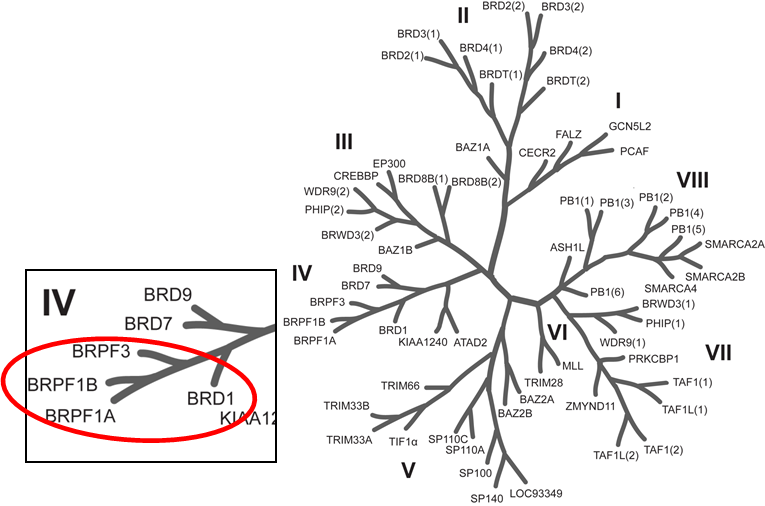
Phylogenetic tree of bromodomains and detailed view at the BRPF family.
A chemical probe for the bromodomain of the BRPF1B has been developed in collaboration with Pfizer. PFI-4 specifically binds to BRPF1B with a KD of 13 nM as determined by ITC. It reduces recovery time in U2OS cells transfected with a BRPF1B triple BRD construct with a nuclear localisation signal (NLS) in the FRAP assay at 500 nM, while showing no effect on BRPF1A. A NanoBRETTM cellular target engagement assay evaluating the interaction of BRPF1B with histones suggested IC50 of 240 nM for PFI-4.
| BRPF | Kd/nM (ITC) | IC50/nM (Alpha Screen) | TM Shift °C |
| BRPF1B | 13 | 172 | 9.4 |
| BRPF2 (BRD1) | 775 | 3600 | 2 |
PFI-4 specifically binds to BRPF1B with a KD of 13 nM as determined by ITC.
PFI-4 induced significant temperature shifts for BRPF1B (ΔTm of 9.4 °C). Weak interactions (2.0 °C) were also observed for BRD1 and CECR2, however the binding to BRD1 shows 60-fold selectivity with a KD of 775 nM and IC50 of 3600 nM. CECR2 was the only detected off-target outside family IV with only 2350 nM affinity, thus showing 167-fold selectivity.
Use PFI-4 at concentrations of around 1 µM. PFI-4 is non-toxic up to 50 μM in U2OS cells.
In a FRAP assay PFI-4 recovery time in U2OS cells transfected with a BRPF1B triple BRD construct with a nuclear localisation signal (NLS) at 500 nM. PFI-4 had no effect on the recovery time of BRPF1A.
In a NanoBRETTM cellular target engagement assay using isolated BRPF1B BRD with NLS and Halo-tagged histone H3.3 BRPF1B isoform showed a dose-dependent displacement from histone H3.3, with estimated cellular IC50 of 240 μM. No PFI-4 had no effect on the BRPF1A isoform.
PFI-4 induces re-localisation of BRPF1B resulting in a more uniform distribution in nuclei and expression in nucleoli as well as a greater expression in cytoplasm PFI-4 has no effect on the BRPF1A isoform.
| Probe |
 |
PFI-4 |
| Physical and chemical properties | |
|---|---|
| Molecular weight | 380.45 |
| Molecular formula | C21H24N4O3 |
| IUPAC name | N-(1,3-dimethyl-2-oxo-6-(pyrrolidin-1-yl)-2,3-dihydro-1H-benzo[d]imidazol-5-yl)-2-methoxybenzamide |
| clogP | 2.23 |
| PSA | 65.12 |
| No. of chiral centres | 0 |
| No. of rotatable bonds | 5 |
| No. of hydrogen bond acceptors | 4 |
| No. of hydrogen bond donors | 1 |
| Storage | Stable as solid in the dark at -20°C. NB making aliquots rather than freeze-thawing is recommended |
| Dissolution | Soluble in DMSO |
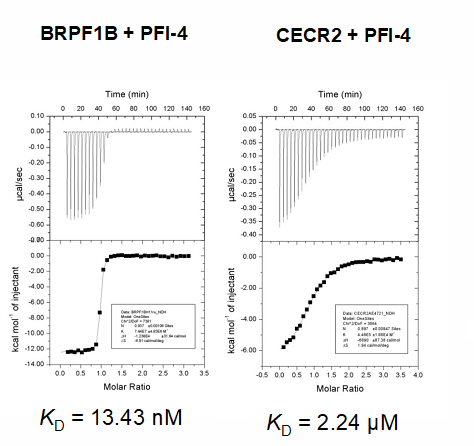
Dissociation constants of PFI-4 and BRDF1B or CECR2 interactions measured by isothermal titration calorimetry (ITC).
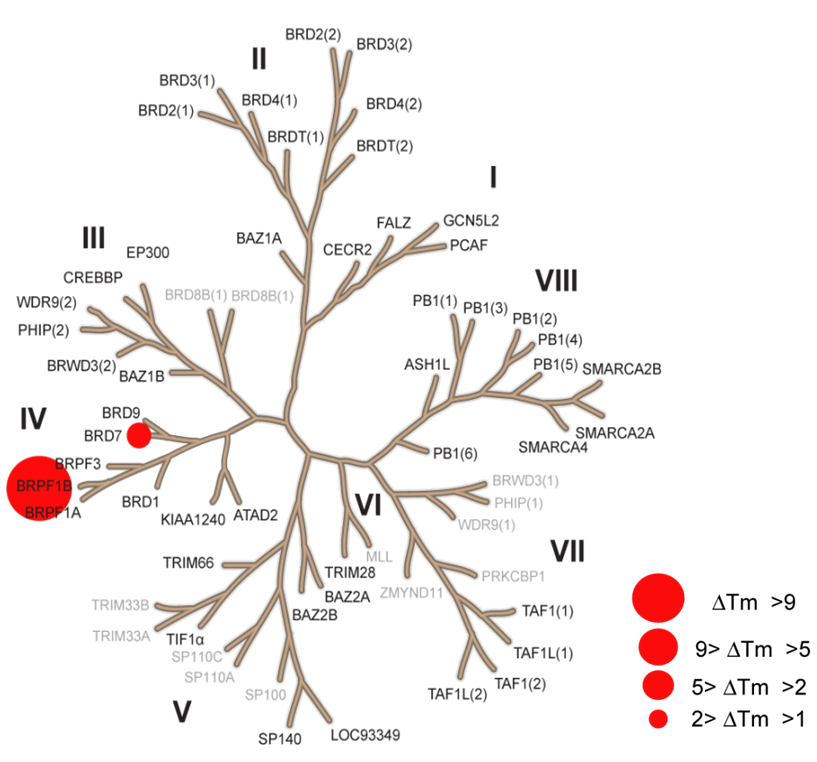
The temperature shifts mapped onto the phylogenetic tree using red circles corresponding to ΔTm as indicated in the figure.
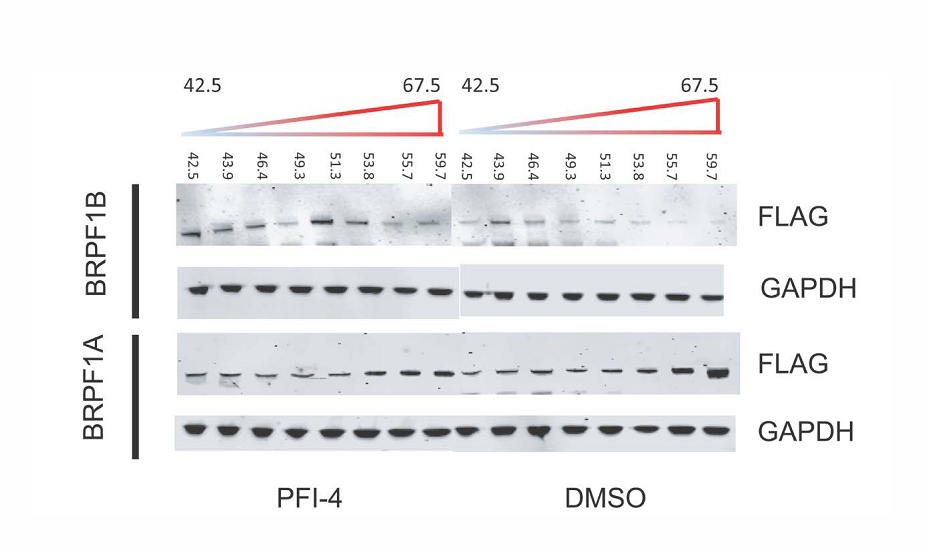
Thermal-stability of BRPF1A/B determined by CESTA at 1 µM PFI-4.
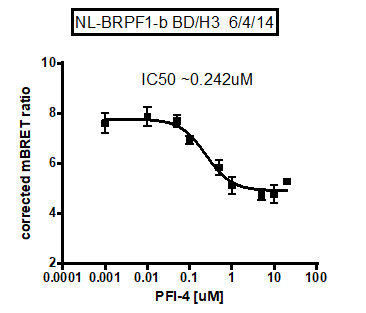
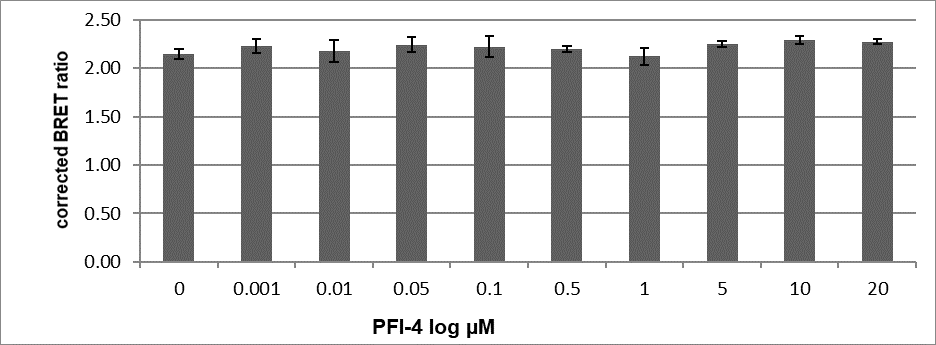
BRET assay using BRPF1A or BRPF1B-BRD with NLS (nuclear localisation signal) and H3.3 after treatment with PFI-4.
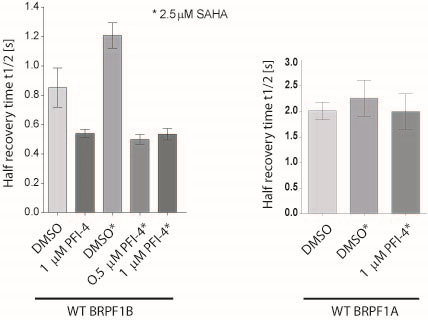
Half-times of fluorescence recovery (t1/2) after photo-bleaching measured for BRPF1B and BRPF1A treated either with or without SAHA and PFI-4 at indicated concentrations.
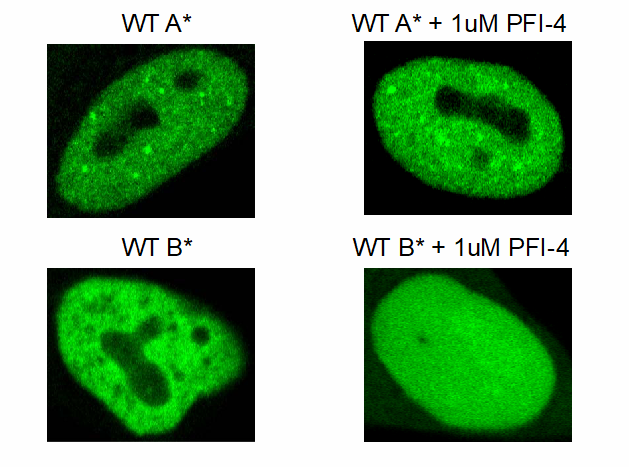
Confocal pictures of U2OS cells transfected with triple BRD–GFP construct of BRPF1B or BRPF1A containing NLS treated either with or without 1 μM PFI-4.
Work on this probe has been published in 'Selective targeting of Bromodomain-PHD fingers family (BRPF) bromodomains impairs osteoclast differentiation'.
Isothermal Titration Calorimetry (ITC)
All calorimetric experiments were performed on a VP-ITC micro-calorimeter (MicroCalTM, LLC Northampton, MA). Protein solutions were buffer exchanged by gel filtration or dialysis into buffer (20 mM Hepes pH 7.5, 150 mM NaCl, and 0.5 mM tris (2-carboxyethyl) phosphine (TCEP). All measurements were carried out at 288.15 K. All injections were performed using an initial injection of 2 µL followed by injections of 8 µL. The data were analysed with the MicroCal ORIGIN software package employing a single binding site model. The first data point was excluded from the analysis.
Temperature shift assay
Thermal melting experiments were carried out using a Stratagene Mx3005p Real Time PCR machine (Agilent Technologies). PFI-4 was added at a final concentration of 10 µM. SYPRO Orange (Molecular Probes) was added as a fluorescence probe at a dilution of 1:1000 as described (6).
AlphaScreen Assay
Assays were performed as described previously with minor modifications (7). All reagents were diluted in 25 mM HEPES, 100 mM NaCl, 0.1 % BSA, pH 7.4 supplemented with 0.05 % CHAPS and allowed to equilibrate to room temperature prior to addition to plates. An 11-point 1:2.0 serial dilutions of the ligands was prepared on lowvolume 384-well plates (ProxiPlateTM-384 Plus, PerkinElmer, USA), using LabCyte Eco liquid handler. Plates filled with 5 µL of the assay buffer followed by 7 µL of biotinylated peptide [H-YSGRGKacGGKacGLGKacGGAKacRHRK(Biotin)-OH for BRD1, BRD4, BRPF1B and BRPF3 or YQTARKSTGGK(ac)APRKQLATKAK(biotin)-OH for TIF1α] and Histagged protein to achieve final assay concentrations of 25-100 nM depending on the dose-response curve for each individual protein. Plates were sealed and incubated for a further 30 minutes, before the addition of 8 µM of the mixture of streptavidin-coated donor beads (12.5 µg/mL) and nickel chelate acceptor beads (12.5 µg/mL) under low light conditions. Plates were foil-sealed to protect from light, incubated at room temperature for 60 minutes and read on a PHERAstar FS plate reader (BMG Labtech, Germany) using an AlphaScreen 680 excitation/570 emission filter set. IC50 values were calculated in Prism 5 (GraphPad Software, USA) after normalization against corresponding DMSO controls.
Fluorescence Recovery After Photobleaching (FRAP) Assay
FRAP studies were performed using U20S cells expressing GFP-bound BRPF1a or BRPF1B (triple bromodomain). Six hours after transfection 2.5 µM SAHA (to increase global histone acetylation) was added and cells were treated with 1 µM or 5 µM of PFI-4 1 hour before imaging and half recovery times from the fluorescence signal of the bleached U2OS nuclei were plotted.
NanoBRET
U2OS cells were co-transfected with Histone H3.3-HaloTag and NanoLuc-BRPF1. Twenty hours post-transfection cells were collected, washed with PBS, and exchanged into media containing phenol red-free DMEM and 4% FBS in the absence (control sample) or the presence (experimental sample) of 100 nM NanoBRET 618 fluorescent ligand (Promega). Cells were then treated with an increasing dose of OF-1. Five minutes prior to reading, NanoBRET furimazine substrate (Promega) was added to both control and experimental samples and plates were read on a CLARIOstar (BMG) equipped with 450/80 nm bandpass and 610 nm longpass filters with a 0.5 sec reading setting. A corrected BRET ratio was calculated and is defined as the ratio of the emission at 610 nm/450 nm for experimental samples (i.e. those treated with NanoBRET fluorescent ligand) subtracted by and the emission at 610 nm/450 nm for control samples (not treated with NanoBRET fluorescent ligand). BRET ratios are expressed as milliBRET units (mBU), where 1 mBU corresponds to the corrected BRET ratio multiplied by 1000. Relative IC50 values were estimated by non-linear regression analysis of (log) concentration of each inhibitor versus milliBRET ratios (GraphPad Prism).
This probe is available from Sigma, Tocris and Cayman Chemical.
| Probe |
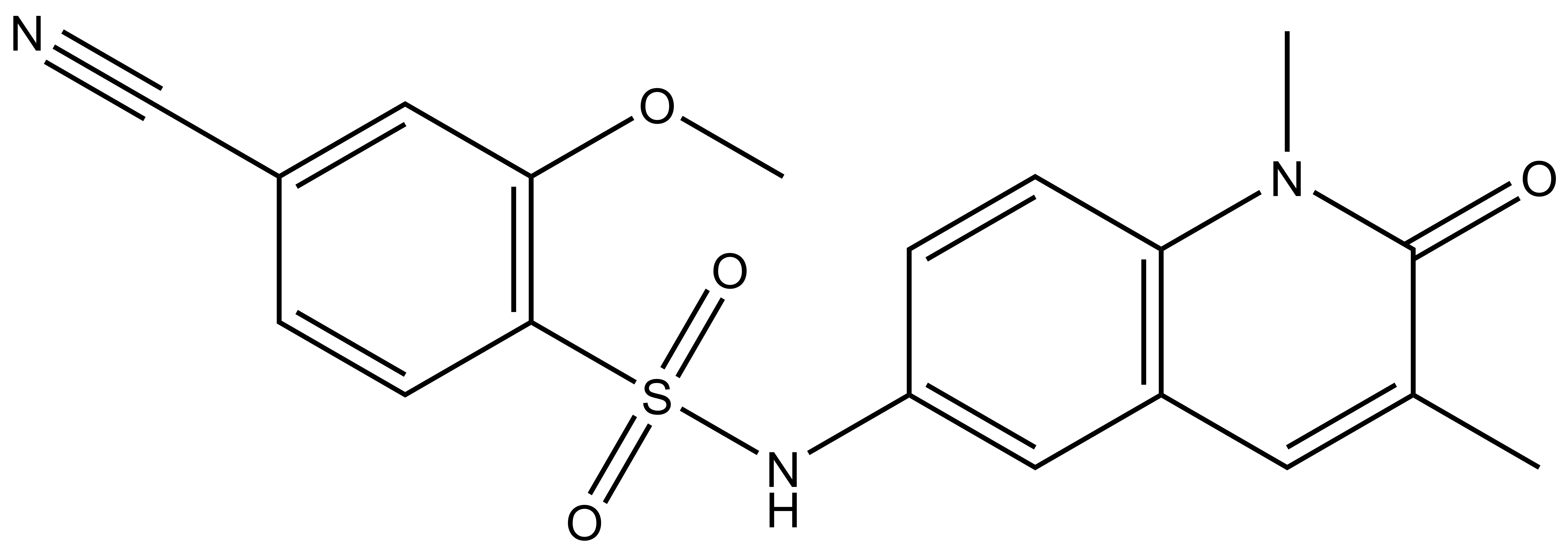 |
NI-57 |
A collaboration between the SGC and University College London (UCL) has resulted in the discovery of NI-57 as a chemical probe for the bromodomains of the BRPF (BRomodomain and PHD Finger) family of proteins (BRPF1/2/3).
BRPF1, BRPF2 (BRD1) and BRPF3 are scaffolding proteins, assembling HAT complexes of the MOZ/MORF family (MOZ, Ybf2/Sas3, Sas2, and Tip60) (1). These MYST complexes have a tetrameric core containing BRPF, the tumour suppressor ING and Eaf6/EPC (enhancer of polycomb)-related scaffold subunits. MYST complexes play crucial roles in DNA repair, recombination, and replication as well as in transcription activation (2,3). MOZ is frequently translocated in AML (acute myeloid leukemia) and is required for HSC proliferation (4).
Two BRPF1 isoforms (isoform A and B) can be generated by alternative splicing. In contrast to BRPF1B, the isoform A harbours a residue insertion in the ZA-loop that prevents binding to acetylated histone peptides (5).
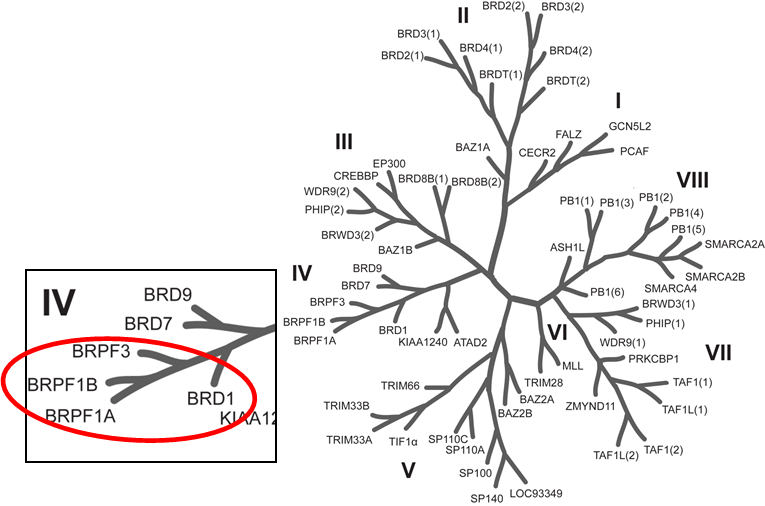
Phylogenetic tree of bromodomains and detailed view at the BRPF family.
NI-57 is a potent inhibitor of the bromodomain of the BRPFs and binds to BRPF1B with a KD of 31 nM (ITC), to BRPF2 with a KD of 108 nM (ITC) and to BRPF3 KD of 408 nM (ITC). NI-57 is very selective against other non-Class IV bromodomains, including the BETs, as measured by both biophysical and biochemical methods. The closest off-target effects are against BRD9 (32-fold selective). NI-57 shows accelerated FRAP recovery at 1 µM in the BRPF2 FRAP assay preventing binding of full-length BRPF2 to chromatin.
NI-57 is a chemical probe with potent binding affinity for BRPF1 (KD of 31 nM), BRPF2 (KD of 108 nM) and to BRPF3 (KD of 408 nM) with good selectivity over BRD9 (KD of 1 μM) and BRD4 (KD of 3.9 μM) as determined by isothermal titration calorimetry (ITC). Alpha screen biochemical assay confirmed NI-57 as a potent inhibitor of BRPF1 (IC50 of 114 nM). No off targets were identified for NI-57 outside the BRD family.
| Bromodomain | Kd/nM (ITC) | IC50/nM (Alpha Screen) | TM Shift °C |
| BRPF1B | 31 | 114 | 10.7±0.3 |
| BRPF2 (BRD1) | 110 | 619 | 5.6±0.1 |
| BRPF3 | 410 | 1010 | 5.3±0.3 |
| BRD9 | 1000 | 4400 | 3.1±0.7 |
| BRD4(1) | 3900 | >10,000 | 0.8±0.6 |
NI-57 showed significant selectivity for BRPF1/2/3 binding by DSF (differential scanning fluorimetry). NI-57 is very selective against other non-Class IV bromodomains, including the BETs, as measured by both biophysical and biochemical methods. The closest off-target effects were determined against BRD9 (32-fold selective). NI-57 shows minimal off-target pharmacology against a panel of GPCRs, ion channels, and enzymes and is functionally active in cellular assays.
We recommend to use NI-57 at concentrations of up to 1 µM and use the BRPF inhibitor OF-1 in parallel to confirm the result.
NI-57 increases thermal stability in the CETSA of full length BRPF1B but not of the BRPF1A isoform.
NI-57 induces dose-dependent displacement of BRPF1B but not of the BRPF1A isoform from histone H3.3 in NanoBRETTM assay with estimated IC50 values of 0.07 μM.
In a FRAP assay BRD1 as well as BRPF1B show reduced recovery time for the displacement of full-length from chromatin in the presence of NI-57.
NI-57 inhibits RANKL/MCSF induced differentiation of primary human monocytes into osteoclasts.
| Probe |
 |
NI-57 |
| Physical and chemical properties | |
|---|---|
| Molecular weight | 383.42 |
| Molecular formula | C19H17N3O4S |
| IUPAC name | 4-cyano-N-(1,3-dimethyl-2-oxo-1,2-dihydroquinolin-6-yl)-2-methoxybenzenesulfonamide |
| logP | 2.05 |
| PSA | 99.5 |
| No. of chiral centres | 0 |
| No. of rotatable bonds | 5 |
| No. of hydrogen bond acceptors | 5 |
| No. of hydrogen bond donors | 1 |
| Storage | Stable as solid in the dark at -20°C. NB making aliquots rather than freeze-thawing is recommended |
| Dissolution | Soluble in DMSO |
Thermal Shift Assay
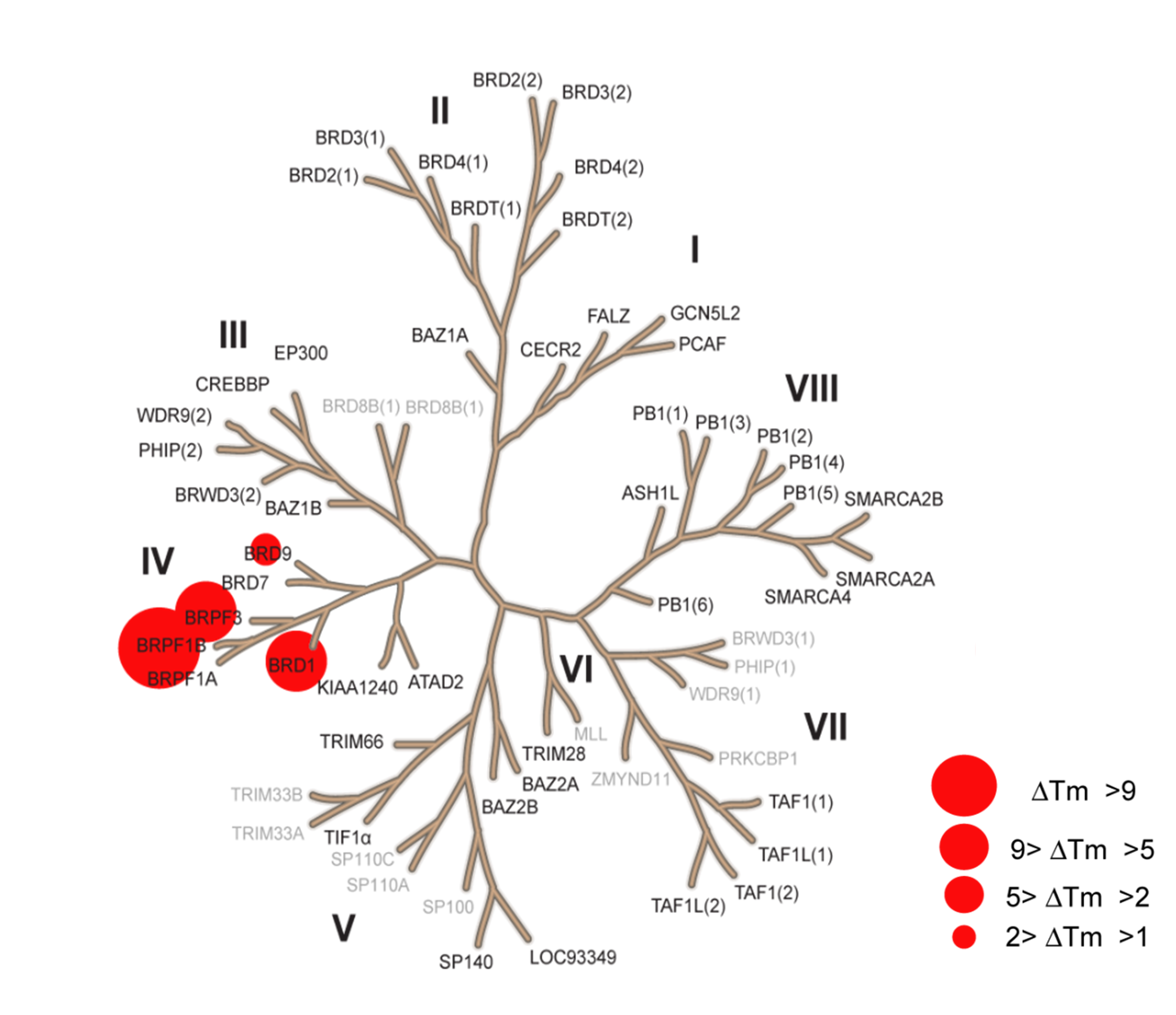
Selectivity profile of NI-57 using temperature shift assay. Temperature shifts ΔTm are indicated by red circles with increasing radii for higher Tm as described in the legend.
CEREP Screen

NI-57 (10 µm) was screened against a panel of 55 ligand receptors, ion channels and transports using an established and widely utilized commercial assay platform (ExpresSProfile; CEREP, Paris, FRANCE).
CESTA
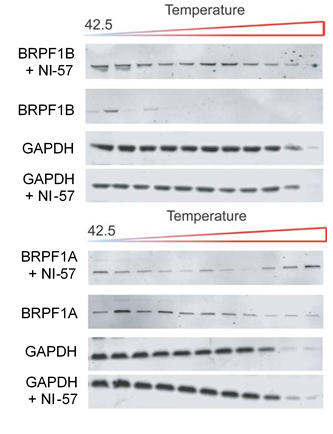
Thermal-stability of BRPF1A/B determined by CESTA upon application of NI-57.

Re-location of BRPF1B to nucleolus and some ‘leak- out’ to cytoplasm in evidence upon compound treatment.
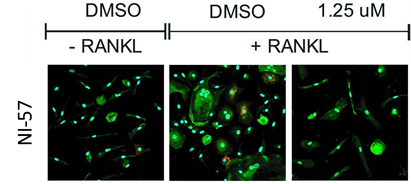
NI-57 attenuates osteoclastogenesis as seen when primary human monocytes (isolated from human cone blood via CD14+bead isolation) were cultured with MCSF (6 days) and the cells then treated with RANKL-/+ followed by NI-57 for at least 14 days. IF was performed with VNR (red), F-Actin (green) and DAPI to visualize the possible bone-resorbing cells
Work on this probe has been published in 'Design of a chemical Probe for the bromodomain and plant homeodomain finger-containing (BrPF) family of proteins' and 'Selective targeting of Bromodomain-PHD fingers family (BRPF) bromodomains impairs osteoclast differentiation'.
Isothermal Titration Calorimetry (ITC)
All calorimetric experiments were performed on a VP-ITC micro-calorimeter (MicroCalTM, LLC Northampton, MA). Protein solutions were buffer exchanged by gel filtration or dialysis into buffer (20 mM Hepes pH 7.5, 150 mM NaCl, and 0.5 mM tris (2-carboxyethyl) phosphine (TCEP). All measurements were carried out at 288.15 K. All injections were performed using an initial injection of 2 µL followed by injections of 8 µL. The data were analysed with the MicroCal ORIGIN software package employing a single binding site model. The first data point was excluded from the analysis.
Temperature shift assay
Thermal melting experiments were carried out using a Stratagene Mx3005p Real Time PCR machine (Agilent Technologies). OF-1 was added at a final concentration of 10 µM. SYPRO Orange (Molecular Probes) was added as a fluorescence probe at a dilution of 1:1000 as described (6).
AlphaScreen Assay
Assays were performed as described previously with minor modifications (7). All reagents were diluted in 25 mM HEPES, 100 mM NaCl, 0.1 % BSA, pH 7.4 supplemented with 0.05 % CHAPS and allowed to equilibrate to room temperature prior to addition to plates. An 11-point 1:2.0 serial dilutions of the ligands was prepared on lowvolume 384-well plates (ProxiPlateTM-384 Plus, PerkinElmer, USA), using LabCyte Eco liquid handler. Plates filled with 5 µL of the assay buffer followed by 7 µL of biotinylated peptide [H-YSGRGKacGGKacGLGKacGGAKacRHRK(Biotin)-OH for BRD1, BRD4, BRPF1B and BRPF3 or YQTARKSTGGK(ac)APRKQLATKAK(biotin)-OH for TIF1α] and Histagged protein to achieve final assay concentrations of 25-100 nM depending on the dose-response curve for each individual protein. Plates were sealed and incubated for a further 30 minutes, before the addition of 8 µM of the mixture of streptavidin-coated donor beads (12.5 µg/mL) and nickel chelate acceptor beads (12.5 µg/mL) under low light conditions. Plates were foil-sealed to protect from light, incubated at room temperature for 60 minutes and read on a PHERAstar FS plate reader (BMG Labtech, Germany) using an AlphaScreen 680 excitation/570 emission filter set. IC50 values were calculated in Prism 5 (GraphPad Software, USA) after normalization against corresponding DMSO controls.
Fluorescence Recovery After Photobleaching (FRAP) Assay
FRAP studies were performed using U20S cells expressing full-length BRPF2 (BRD1). Six hours after transfection 2.5 µM SAHA (to increase global histone acetylation) was added and cells were treated with 1 µM or 5 µM of OF-1 1 hour before imaging and half recovery times from the fluorescence signal of the bleached U2OS nuclei were plotted.
NanoBRET
U2OS cells were co-transfected with Histone H3.3-HaloTag and NanoLuc-BRPF1. Twenty hours post-transfection cells were collected, washed with PBS, and exchanged into media containing phenol red-free DMEM and 4% FBS in the absence (control sample) or the presence (experimental sample) of 100 nM NanoBRET 618 fluorescent ligand (Promega). Cells were then treated with an increasing dose of OF-1. Five minutes prior to reading, NanoBRET furimazine substrate (Promega) was added to both control and experimental samples and plates were read on a CLARIOstar (BMG) equipped with 450/80 nm bandpass and 610 nm longpass filters with a 0.5 sec reading setting. A corrected BRET ratio was calculated and is defined as the ratio of the emission at 610 nm/450 nm for experimental samples (i.e. those treated with NanoBRET fluorescent ligand) subtracted by and the emission at 610 nm/450 nm for control samples (not treated with NanoBRET fluorescent ligand). BRET ratios are expressed as milliBRET units (mBU), where 1 mBU corresponds to the corrected BRET ratio multiplied by 1000. Relative IC50 values were estimated by non-linear regression analysis of (log) concentration of each inhibitor versus milliBRET ratios (GraphPad Prism).
Human osteoclast differentiation
Primary human peripheral blood mononuclear cells (PBMCs) were collected from a Histopaque generated buffy coat after gradient centrifugation at 20 min and 500g, brakes off. The CD14+ monocyte fraction was obtained by on-column CD14+-MACS bead isolation, washed twice with MACS buffer, and seeded at a density of 50 000 c/mL in αMEM/10%FCS supplemented with 25 ng/mL MCSF. After 6 days at 37 °C, 5% CO2 treatment with NI-57 with and without 50 ng/mL RANKL was started. Media were changed with fresh compound every 3−4 days. After 14−21 days, cells were fixed and stained. IF was performed with VNR (red), F-Actin (green) and DAPI to visualize the possible bone-resorbing cells
This probe is available from Cayman Chemical and Tocris.
Its negative control (ent-LP99) is available for purchase from Tocris.
| Probe | Negative control | |
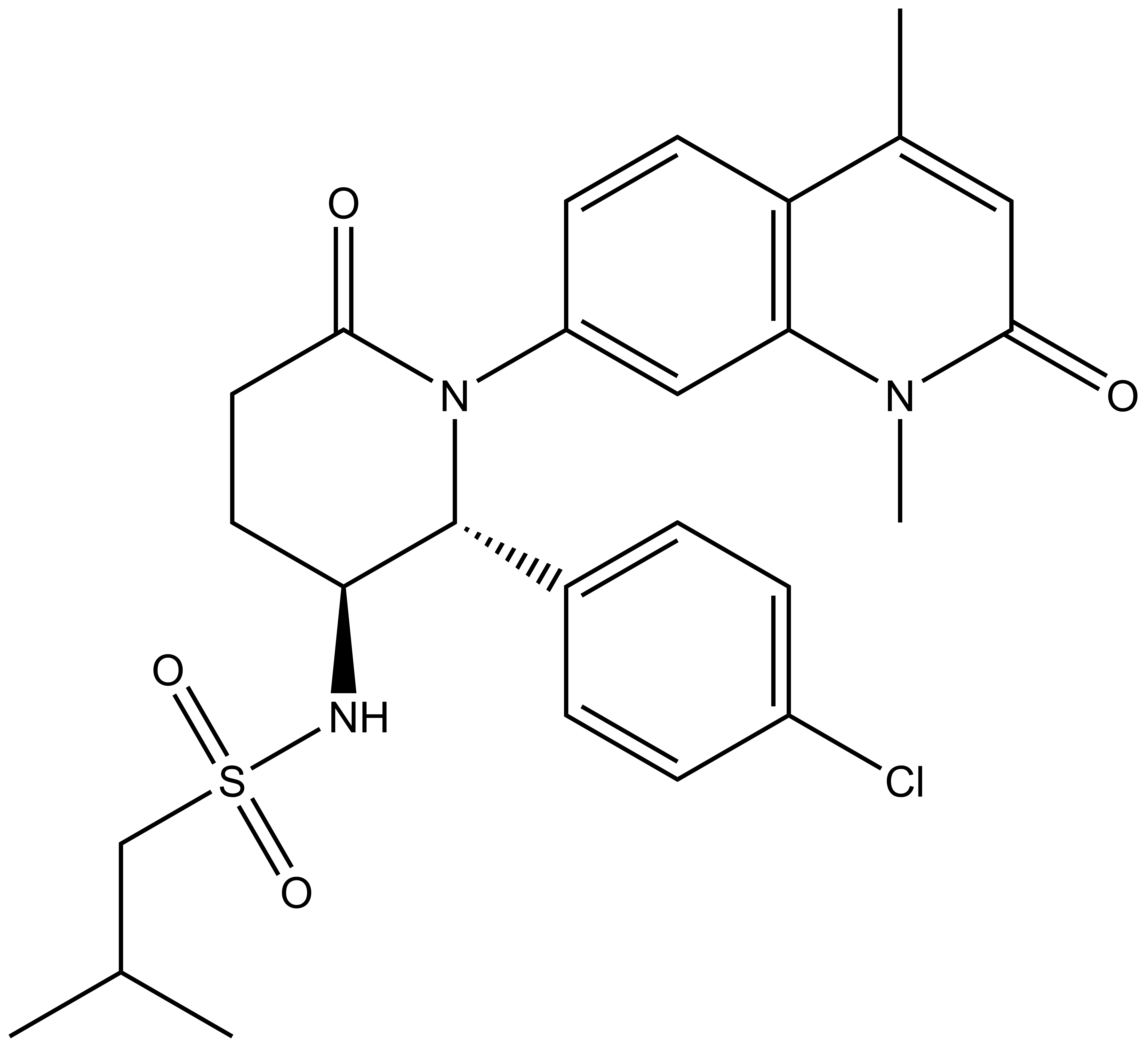 |
| 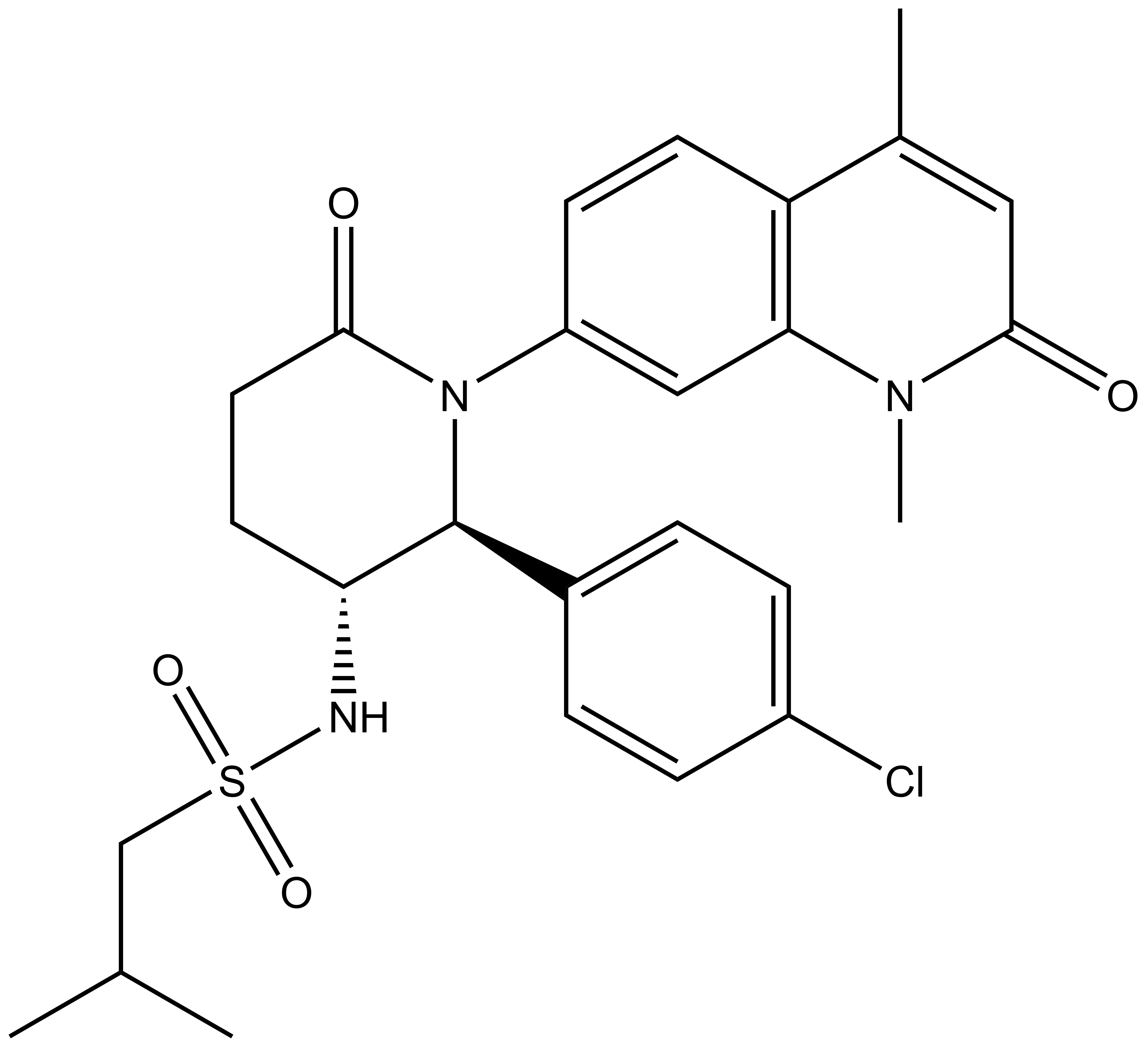 |
LP99 |
| 2S,3R-Enantiomer |
BRD7 and BRD9 are related bromodomain- containing proteins that form a small sub-branch of the bromodomain family tree [1]. Human BRD9 contains a single bromodomain and has five isoforms that are produced by alternative splicing. Little is known about BRD9 function; BRD7 has been reported to act both as coactivator, for example for some p53 target genes and as corepressor, negatively regulating the GSK3B phosphotransferase activity. Both proteins have been implicated in chromatin remodelling as part of the SWI/SNF complex. BRD7 has been described as transcriptional corepressor that down-regulates the expression of target genes. Its binding to promoters also leads to increased histone H3 acetylation at 'Lys-9' (H3K9ac).
LP99, a BRD7/9 specific inhibitor, is a result of collaboration with Professor Darren J. Dixon at the University of Oxford [2]
Chemical structure of the active enantiomer (2R, 3S)-LP99. The enantiomer (2S, 3R)-LP99 is inactive against BRD9. The chiral centres are highlighted by a *.
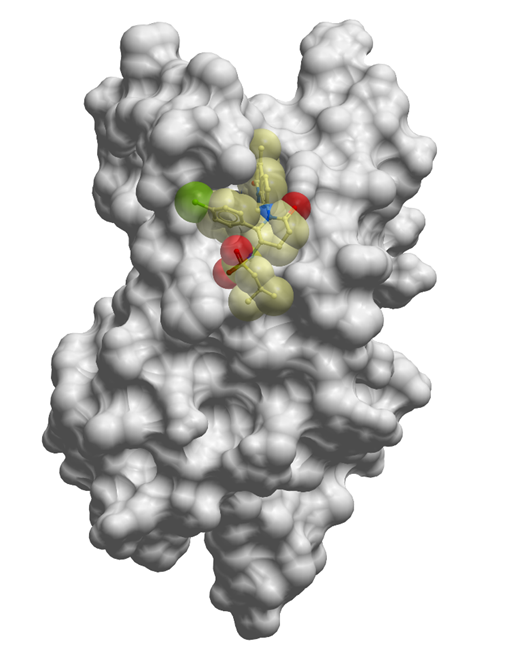
The co-crystal structure of LP99 (yellow) with BRD9 BRD has been solved, click on the 'Co-Crystal structures' tab above for more details.
LP99 is a potent binder to BRD9 with a KD = 99 nM as shown by ITC and was found to bind to the family member BRD7 with 10 fold lower affinity. The importance of chirality and configuration in this work is highlighted by the fact that the enantiomer of LP99, (2S, 3R)-LP99 showed no detectable binding to BRD9 by ITC.
This binding affinity was confirmed by HT-FRET where LP99 has an IC50 of 325nM
Selectivity
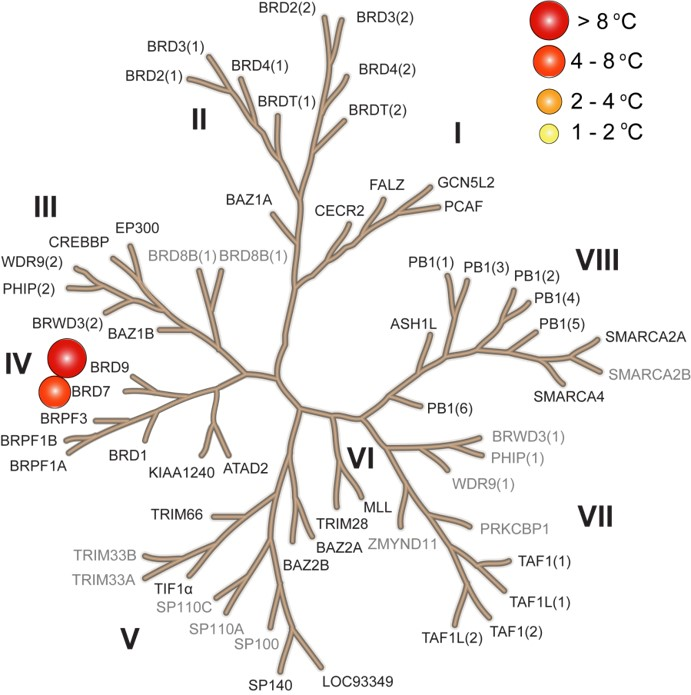
P. Clark et al, Angewandte Chemie Int. Ed. 2015
LP99 is a potent binder to BRD9 with a KD = 99 nM as shown by ITC and was found to bind to the family member BRD7 with 10 fold lower affinity. The importance of chirality and configuration in this work is highlighted by the fact that the enantiomer of LP99, (2S, 3R)-LP99 showed no detectable binding to BRD9 by ITC.
This binding affinity was confirmed by HT-FRET where LP99 has an IC50 of 325nM
LP99 was found to be inactive vs 55 receptors and ion channels (CEREP panel) at 10 µM, 66% antagonist binding inhibition to NK3 was the most potent activity measured.
Cellular assays (FRAP, NanoBRET) demonstrate that the BRD7/9 inhibitor LP99 is able to disrupt the binding of BRD7 and BRD9 to chromatin in cells. Additionally, no cytotoxicity in U2OS cells was observed at 33 µM
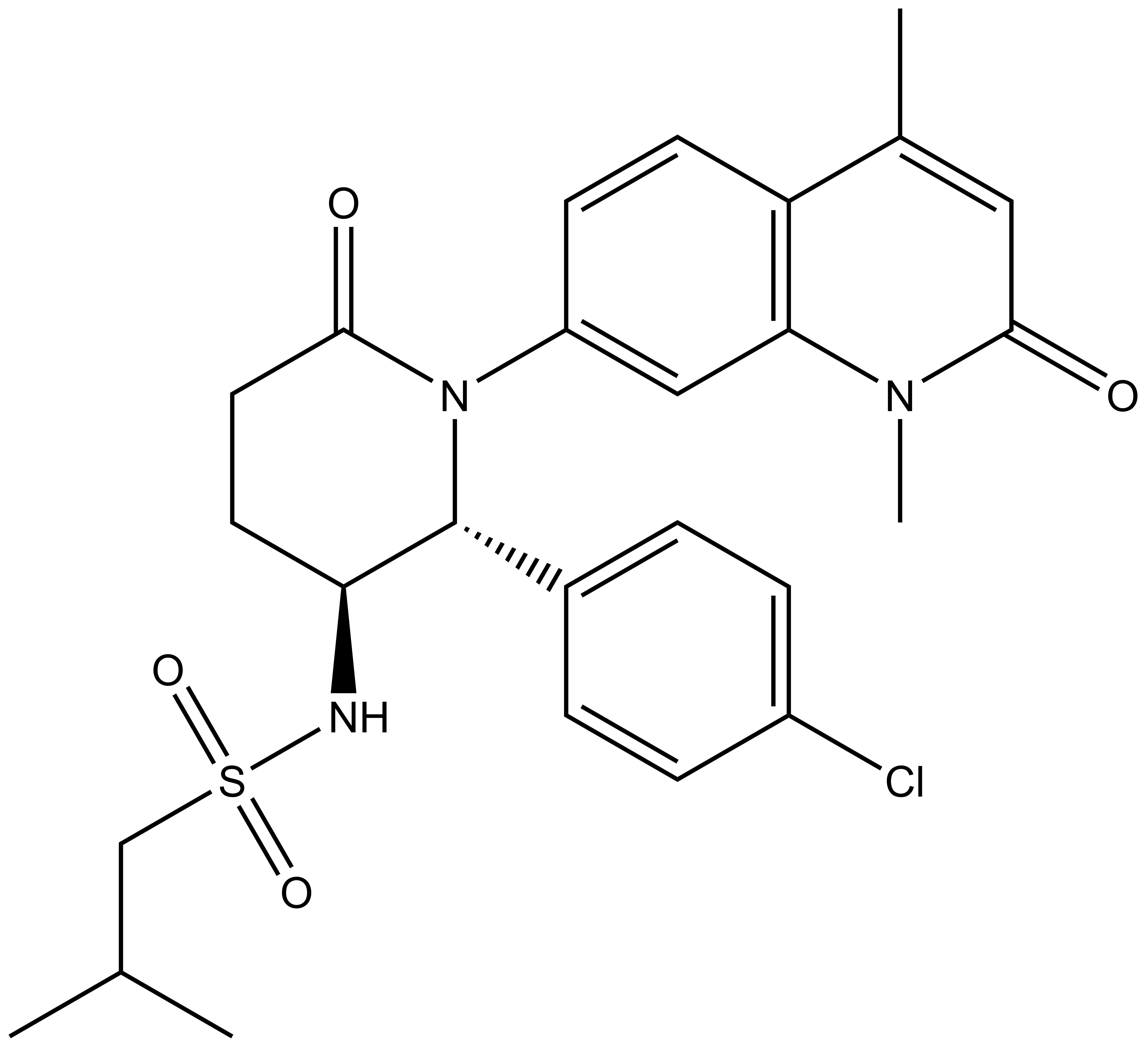 |
N-((2R,3S)-2-(4-chlorophenyl)-1-(1,4-dimethyl-2-oxo-1,2-dihydroquinolin-7-yl)-6-oxopiperidin-3-yl)-2-methylpropane-1-sulfonamide |
| Physical and chemical properties | |
|---|---|
| Molecular weight | 516.05 |
| Molecular formula | C26H30ClN3O4S |
| IUPAC name | N-((2R,3S)-2-(4-chlorophenyl)-1-(1,4-dimethyl-2-oxo-1,2-dihydroquinolin-7-yl)-6-oxopiperidin-3-yl)-2-methylpropane-1-sulfonamide |
| logP | 4.75 |
| PSA | 86.79 |
| No. of chiral centres | 2 |
| No. of rotatable bonds | 4 |
| No. of hydrogen bond acceptors | 9 |
| No. of hydrogen bond donors | 1 |
| Storage | Stable as solid in the dark at -20°C. NB making aliquots rather than freeze-thawing is recommended |
| Dissolution | Soluble in DMSO at least up to ??? |
LP99 is a potent binder to BRD9 with a KD = 99 nM as shown by ITC. This binding is entirely driven by enthalpic interactions (ΔH=-11 kcal/mol), with a net loss in entropy upon binding (TΔS=-2.0 kcal/mol), which is consistent with a number of specific interactions with the protein. LP99 was found to bind to the family member BRD7 with 10 fold lower affinity. The importance of chirality and configuration in this work is highlighted by the fact that the enantiomer of LP99 showed no detectable binding to BRD9 by ITC.
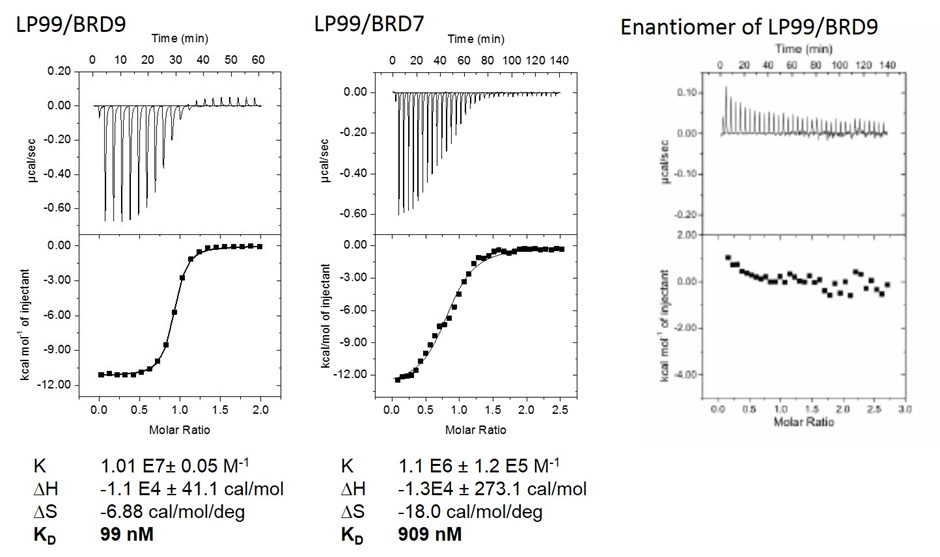
LP99 binds to BR9 with an IC50 of 325nM. The enantiomer (2S, 3R)-LP99 is inactive
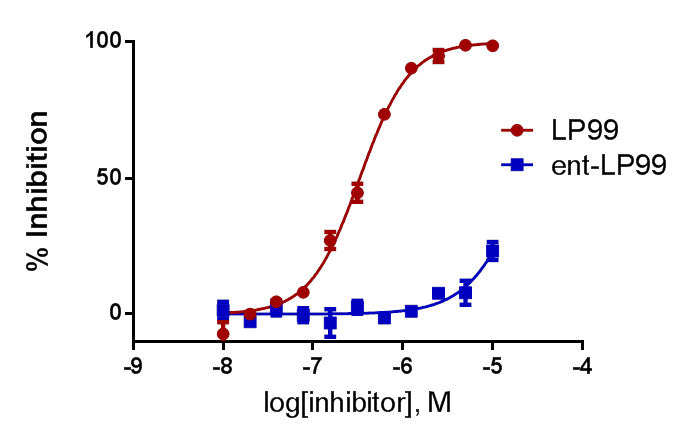
LP99 binds to BRD9 and BRD7 with high selectivity over other members of the Bromodomain family including members of the IV subfamily.
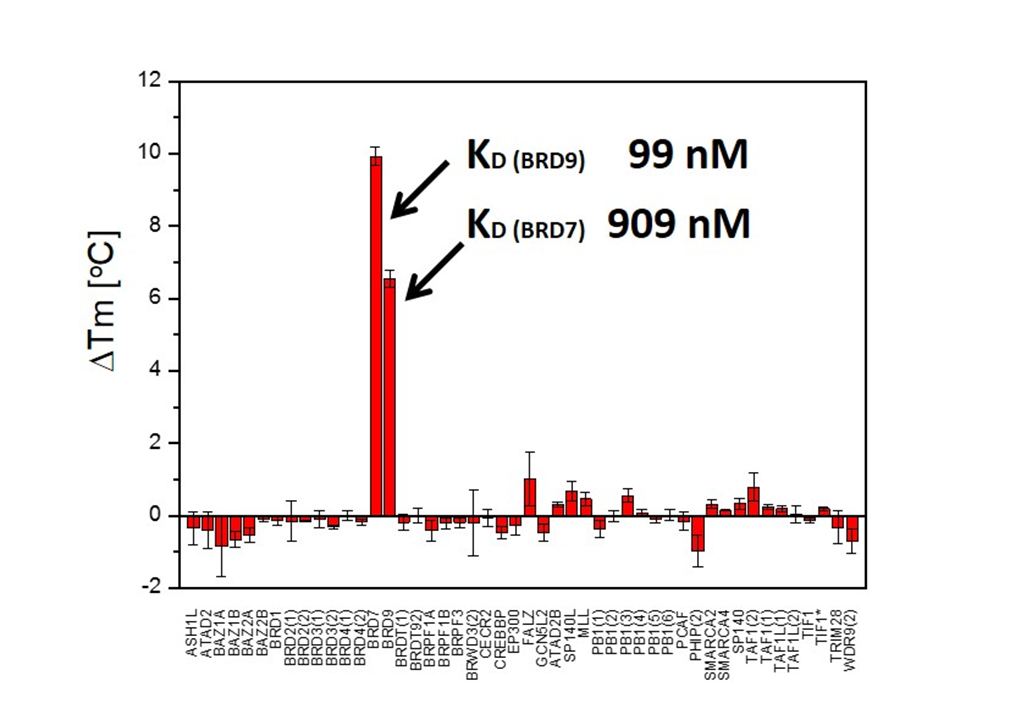
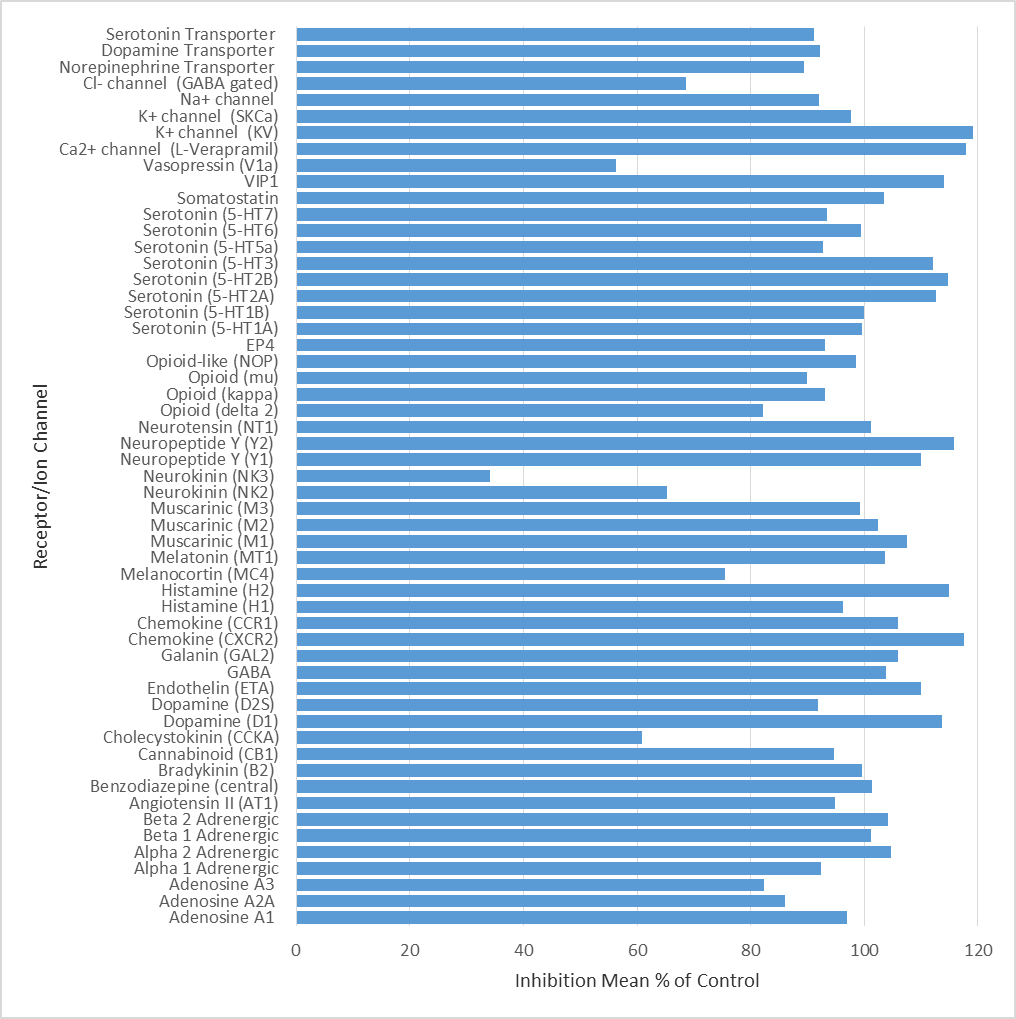
The cellular efficacy of LP99 on BRD9 was investigated using a fluorescence recovery after photo-bleaching (FRAP) assay [18]. LP99 was found to have a dose dependent effect on FRAP recovery time, with higher doses showing a t1/2 akin to that of cells expressing a N100F BRD9 mutant unable to bind histone proteins.
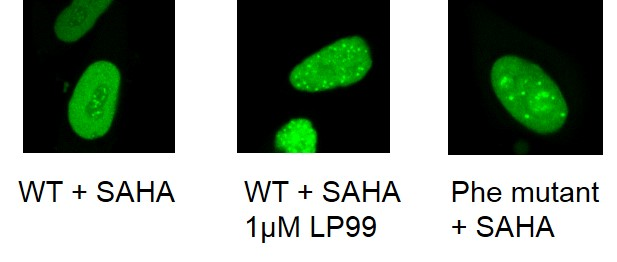
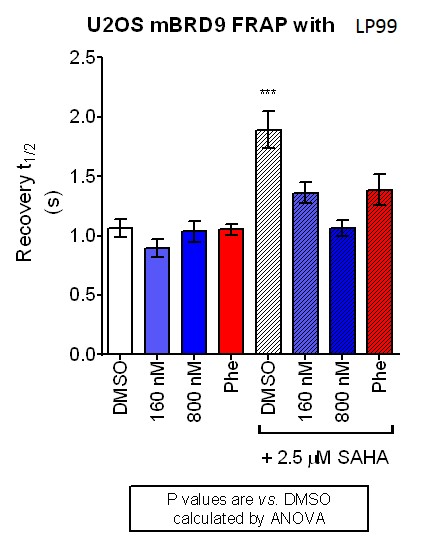
To measure this further, a bioluminescence resonance energy transfer (BRET) assay was performed. BRD7–and BRD9–NanoLuc luciferase fusion proteins and fluorescently labelled histone H3.3– and H4–HaloTag fusions were expressed in HEK293 cells.[19] The addition of LP99 decreased BRET for both BRD7 and BRD9 in both the H3.3 and H4 systems in a dose-dependent manner.
| Interaction | IC50 (uM) | Interaction | IC50 (uM) |
|---|---|---|---|
| BRD7-H3.3 | 3.7 ± 0.27 (4) | BRD9-H3.3 | 5.1 ± 0.50 (4) |
| BRD7-H4 | 3.3 ± 0.20 (4) | BRD9-H4 | 6.2 ± 0.59 (4) |
Cytotoxicity tests in U2OS cells for 24 and 72 hours showed the inhibitor to be non-toxic at concentrations of <33 uM.
Cytotoxicity tests in U2OS cells for 24 and 72 hours showed the inhibitor to be non-toxic at concentrations of <33 uM
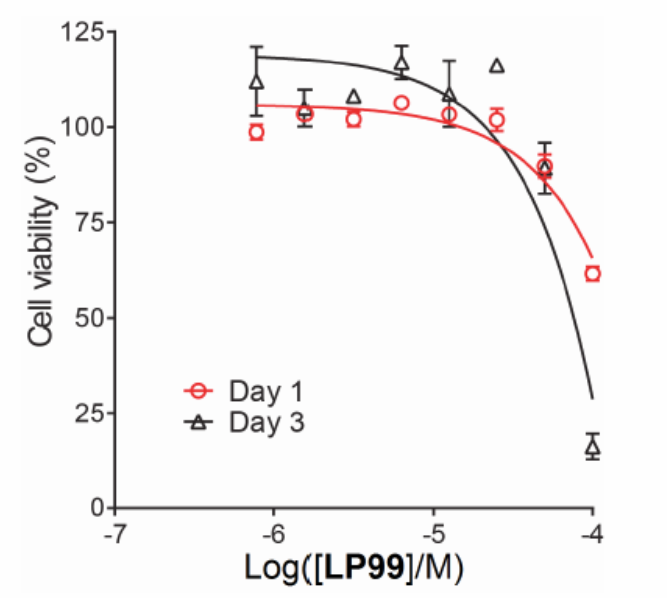
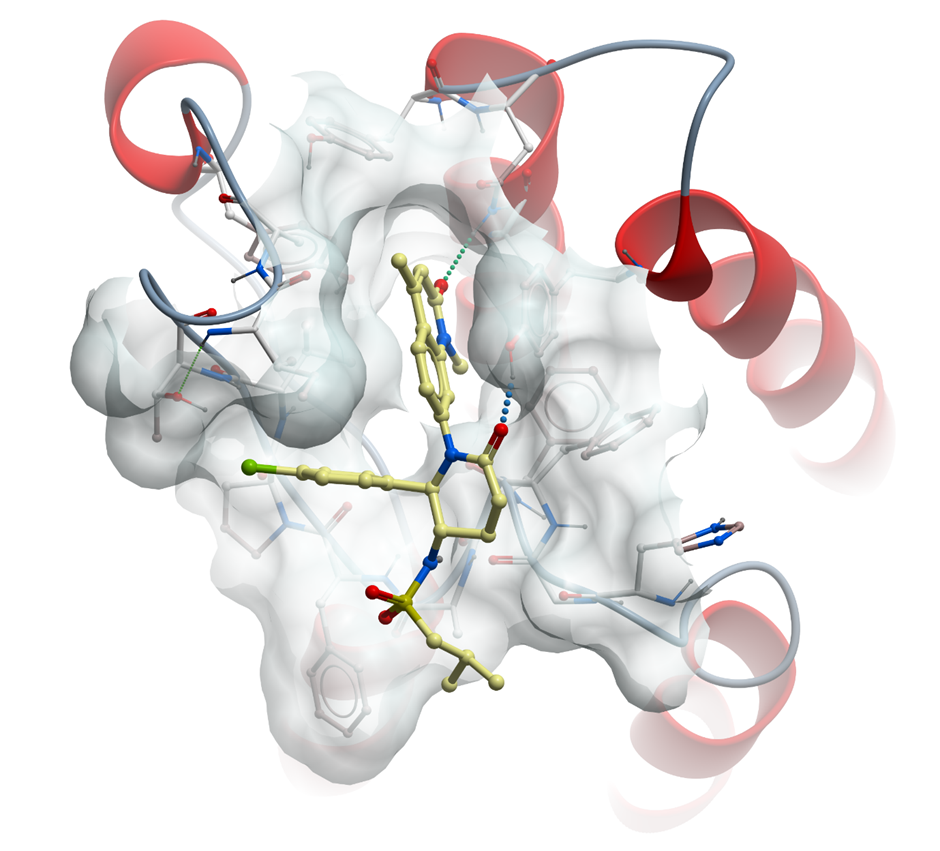
The co-crystal structure of LP99 with BRD9 has been solved with a resolution of 1.7 Å. The key features are
Isothermal Titration Calorimetry
Experiments were carried out on a VP-ITC titration microcalorimeter from MicroCalTM, LLC (Northampton, MA). All experiments were carried out at 15 °C while stirring at 295 rpm, in ITC buffer (50 mM HEPES pH 7.4 at 25 °C, 150 mM NaCl). The injection syringe (250 µl) was loaded with a solution of the protein sample (300 µM protein for the BETs, 950 µM protein for CREBBP and 600 µM for WDR9(2), in ITC buffer). All titrations were conducted using an initial injection of 2 µl followed by 34 identical injections of 8 µl with a duration of 16 sec (per injection) and a spacing of 250 sec between injections. The heat of dilution was determined by independent titrations (protein into buffer) and was subtracted from the experimental data. The collected data were implicated in the MicroCalTM Origin software supplied with the instrument to yield enthalpies of binding (ΔH) and binding constants (KB) as previously described by Wiseman and coworkers50. Thermodynamic parameters were calculated (ΔG = ΔH - TΔS = -RTlnKB, where ΔG, ΔH and ΔS are the changes in free energy, enthalpy and entropy of binding respectively). In all cases a single binding site model was employed.
TR-FRET BRD9 Binding Assay Using the EPIgeneousTM Binding Domain Kit B
This procedure is intended to measure the interaction between the BRD9 bromodomain and a peptide modified by acetylation of 4 lysine residues and can be used to assay compounds which bind to the bromodomain and inhibit this interaction. The assay uses a GST tagged BRD9 with anti-GST antibody conjugated Eu3+ cyrptate (donor) and a biotinylated peptide with Streptavidin conjugated XL-665 (acceptor). When the donor and acceptor labels are in close proximity, by binding of the peptide by the bromodomain, the excitation of the donor (337 nm) triggers a Fluorescence Resonance Energy Transfer (FRET) to the acceptor which then fluoresces at specific wavelength (665 nm)
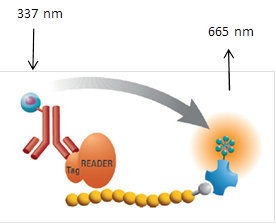
This assay was run using kit B from CisBio in accordance to manufacturer protocol.
strong>Differential Scanning Fluorimetry (DSF)
Thermal melting experiments were carried out using an Mx3005p Real Time PCR machine (Stratagene). Proteins were buffered in 10 mM HEPES pH 7.5, 500 mM NaCl and assayed in a 96-well plate at a final concentration of 2 µM in 20 µl volume. Compounds were added at a final concentration of 10 µM. SYPRO Orange (Molecular Probes) was added as a fluorescence probe at a dilution of 1:1000. Excitation and emission filters for the SYPRO-Orange dye were set to 465 nm and 590 nm, respectively. The temperature was raised with a step of 3 °C per minute from 25 °C to 96 °C and fluorescence readings were taken at each interval. Data was analysed as previously reported [3]
CEREP assay
LP99 (10 µM) was screened against a panel of 55 ligand receptors, ion channels and transports using an established and widely utilized commercial assay platform (ExpresSProfile; CEREP, Paris, FRANCE).
Fluorescence Recovery After Photobleaching (FRAP) Assay
FRAP studies were performed using U20S cells expressing full-length BRD9 protein fused with an N-terminal eGFP as previously described [4]. Six hours after transfection 2.5uM SAHA (to increase global histone acetylation) was added and LP99 was added 1 hour before imaging, which was carried out 24 hours after transfection. Percent inhibition was calculated between the DMSO treated (0%) and N100F expressing mutant (100%)
NanoLuciferase Bioluminescent Resonance Energy Transfer (NanoBRET) Assay
HEK293 cells (8x105) were plated in each well of a 6-well plate and co transfected with one acceptor, Histone H3.3-HaloTag (NM_002107) or Histone H4 HaloTag (P62805); and one donor NanoLuc-BRD9 (Q9H8M2) BRD domain amino acids 120-240 or NanoLuc-BRD7 (NM_001173984) BRD domain amino acids 120-237. The cells were collected 20 hours after transfection, washed with PBS and exchanged into media containing phenol red-free DMEM and 4% FBS in the absence (control) or presence of 100nM NanoBRET 618 fluorescent ligand (Promega). Cell density was adjusted to 2x105 cells/ml and then re-plated into a 96-well white plate (Corning Costar #3917). LP99 was added at final concentrations between 0 and 33 uM and the plates incubated for 18hr at 37˚C in the presence of 5% CO2. NanoBRET furimazine substrate (Promega) was added at a final concentration of 10 uM. Readings were performed within 5 minutes using CLARIOstar (BMG) equipped with 450/80 nm bandpass and 610 nm longpass filters with a 0.5 s reading setting. A corrected BRET ratio was calculated (defined as ratio of emission at 610 nm/450 nm for samples treated with NanoBRET fluorescent ligand and emission at 610 nm/450 nm for samples not treated with NanoBRET fluorescent ligand). BRET ratios expressed as milli-BRET units (mBU) where 1 mBU corresponds to the corrected BRET ratio x 1000.
Cytotoxicity Assay
U20S cells were harvested from exponential phase cultures and plated in a 96-well opaque flat bottomed plates at a cell density of 3 x 103 cells/well (100uL). Compounds were dissolved in DMSO at 10 mM serial dilutions performed. 5 uL of compound solution was added to each well and incubated for 24 or 72 hours at 37˚C in a humidified atmosphere containing CO2 (5%). 10 uL of WST-1 (Roche) was added and the plates returned to the incubator. Plates were read on a plate reader at 450 nm after 2 h for cells treated with LP99 for 24 h or after 1 h for cells treated with LP99 for 72 h. Results plotted as % of DMSO control.
This probe is available from Sigma and Cayman Chemical.
The negative control GSK8573 is available from Sigma.
| Probe | Negative control | |
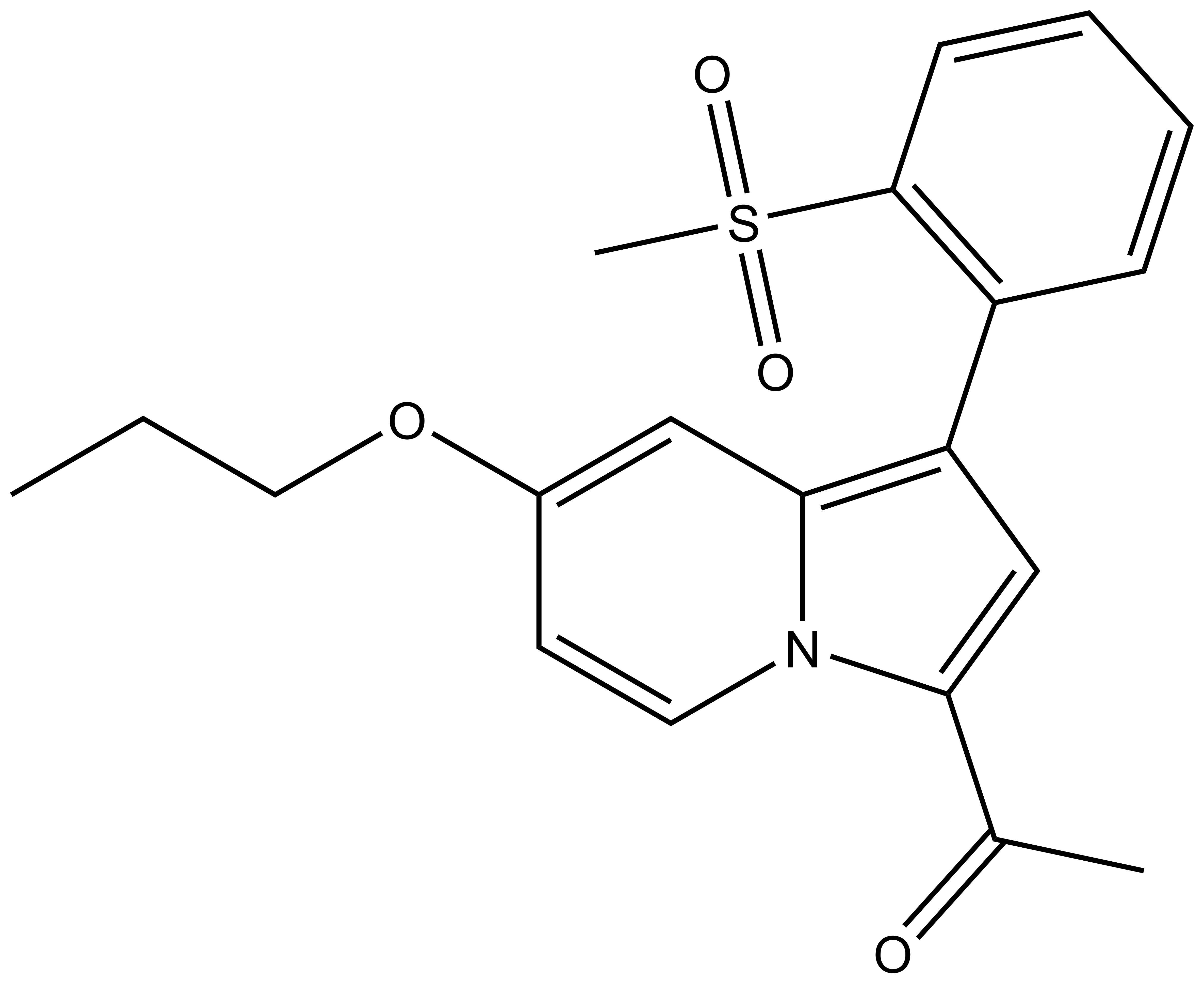 |
| 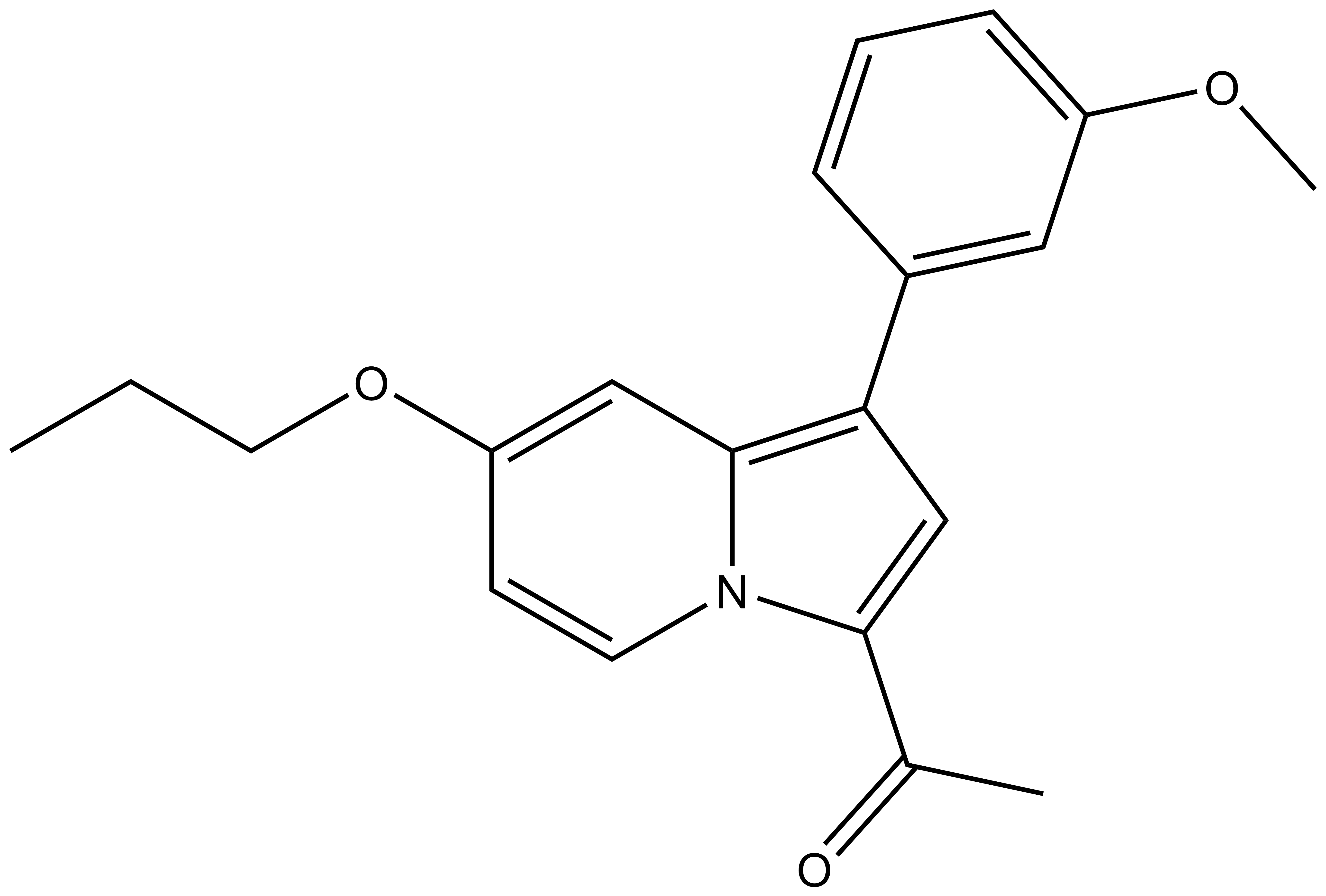 |
GSK2801 |
| GSK8573 |
Biology of the BAZ2 Bromodomains
BAZ2A/B belong to a family of ubiquitously expressed bromodomain containing proteins. Proteins of the BAZ (bromodomain adjacent zinc finger) family are characterized by a carboxy-terminal bromodomain adjacent to a PHD finger and a WACZ motif. In addition four other conserved motifs are typically found in the N-terminus of BAZ family members, namely the LH motif (a leucine-rich helical domain), the ZB2 motif (conserved between ZK783.4 and BAZ2 proteins) and the BAZ 1 and BAZ 2 motifs (conserved between all BAZ proteins, Acf, and ZK783.4).
Little is known about the biological function of BAZ2B but it has been suggested to regulate nucleosome mobilization by the ATP-dependent chromatin remodelling factor ISWI. Interaction of BAZ2B with ISWI is mediated by the BAZ1 motif [1]. The BAZ2B locus has also been identified as associated with sudden cardiac death [2]. The related BAZ2A (also called TIP5) protein plays a central role in the NoRC (nucleolar remodelling complex). BAZ2A is essential for heterochromatin formation leading to transcriptional silencing of certain rRNAs [3].
GSK2801: A Chemical Probe for BAZ2A/B
GSK2801 a BAZ2A/B selective inhibitor is the result of a collaboration with GSK [4]. A second probe against this target, BAZ2-ICR, has also been reported [5].
An inactive control GSK8573 has also been reported (see properties tab).
Co-crystal structure
The co-crystal structure of GK2801 and BAZ2B has been solved (pdb id: 4RVR).
Potency Against Target Family
GSK2801 has been shown by ITC to bind to BAZ2A with a KD of 257 nM and to BAZ2B with a KD of 136 nM.
Selectivity
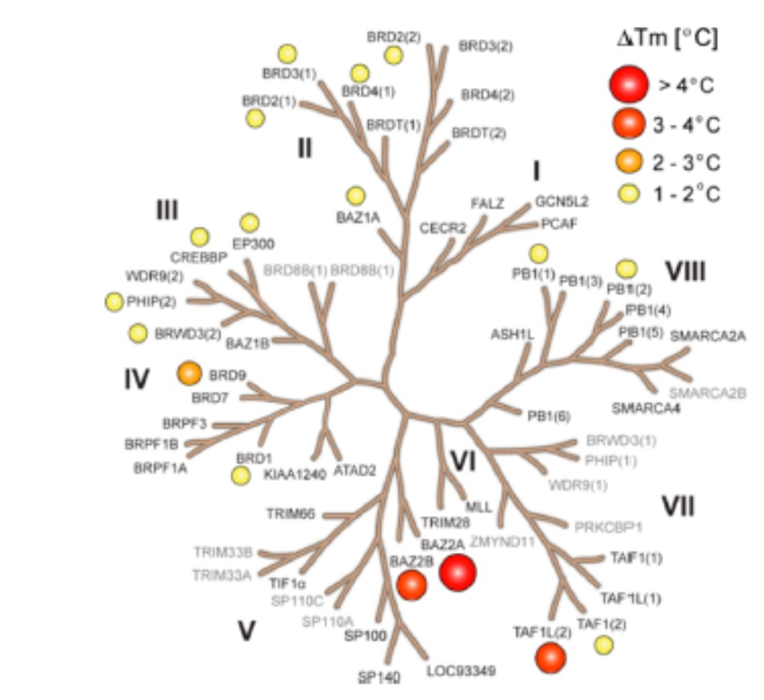
GSK2801 was screened at 10 μM concentration against 47 bromodomains using a thermal shift assay. Moderate activity was observed against TAF1L and BRD9 but GSK2801 was otherwise selective. The screened targets are labelled on the phylogenetic tree; targets that have not been screened are shown in grey. Temperature shifts are represented as spheres as indicated in the figure.
Selectivity Beyond Target Family
GSK2801 was screened in a binding assay against 55 receptors and ion channels and was found to be inactive against all but the Melatonin (MT-1) receptor.
Cellular Activity
GSK2801 accelerated FRAP half-recovery time to the same extent as observed for the mutant construct indicating that the compound was able to displace BAZ2A from chromatin FRAP assay.
| GSK2801 |
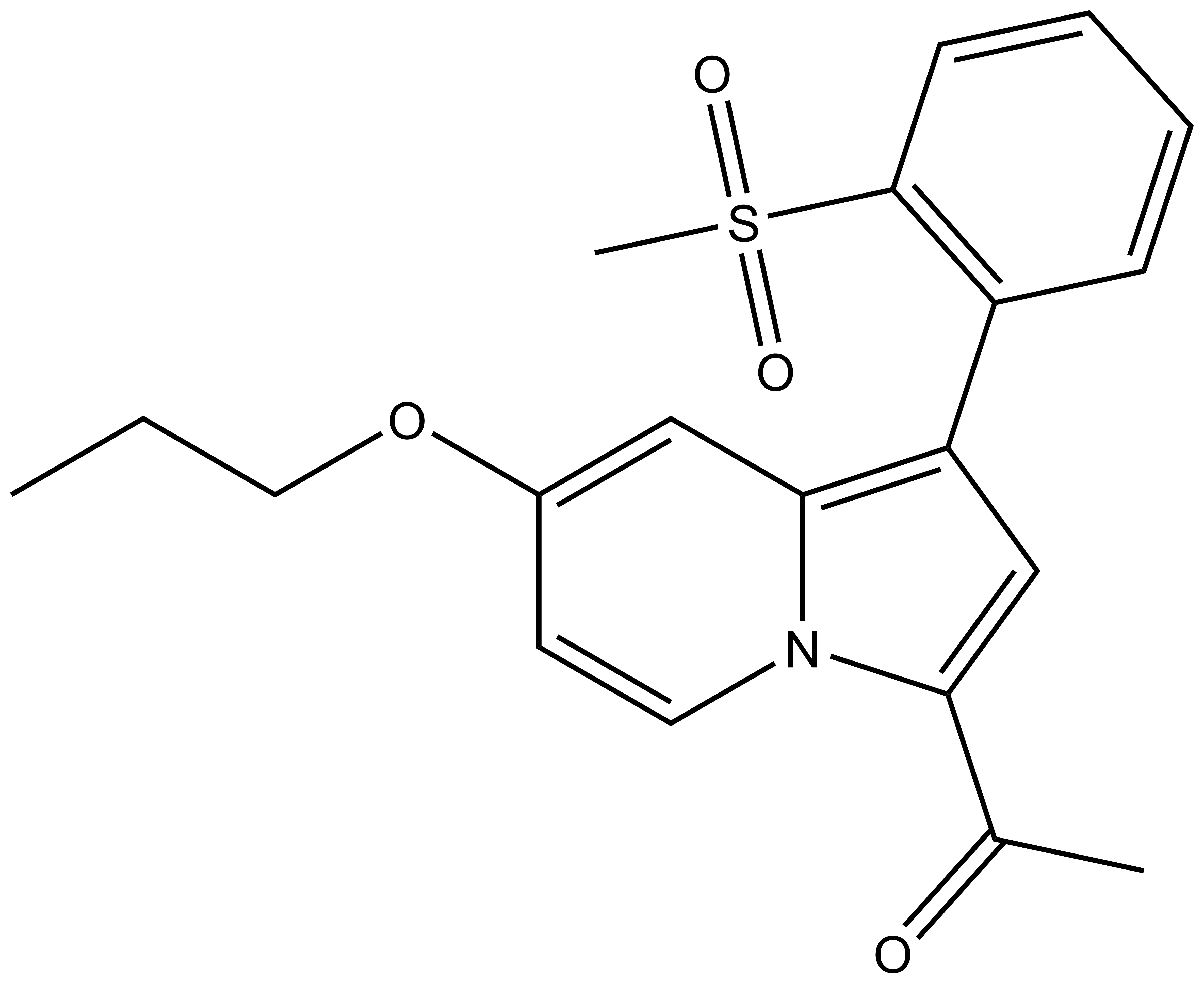 |
1-(1-(2-(methylsulfonyl)phenyl)-7-propoxyindolizin-3-yl)ethan-1-one |
| Physical and chemical properties | |
|---|---|
| Molecular weight | 371.45 |
| Molecular formula | C20H21NO4S |
| IUPAC name | 1-(1-(2-(methylsulfonyl)phenyl)-7-propoxyindolizin-3-yl)ethan-1-one |
| logP | 3.54 |
| PSA | 63.68 |
| No. of chiral centres | 0 |
| No. of rotatable bonds | 6 |
| No. of hydrogen bond acceptors | 5 |
| No. of hydrogen bond donors | 0 |
| Storage | Stable as solid in the dark at -20°C. NB making aliquots rather than freeze-thawing is recommended |
| Solubility | Soluble in DMSO at least up to 50uM |
SMILES: CCCOC1=CC2=C(C3=C(S(=O)(C)=O)C=CC=C3)C=C(C(C)=O)N2C=C1
InChI: InChI=1S/C20H21NO4S/c1-4-11-25-15-9-10-21-18(14(2)22)13-17(19(21)12-15)16-7-5-6-8-20(16)26(3,23)24/h5-10,12-13H,4,11H2,1-3H3
InChI Key: KHWCPNJRJCNVRI-UHFFFAOYSA-N
| The negative control GSK8573 has the following properties |
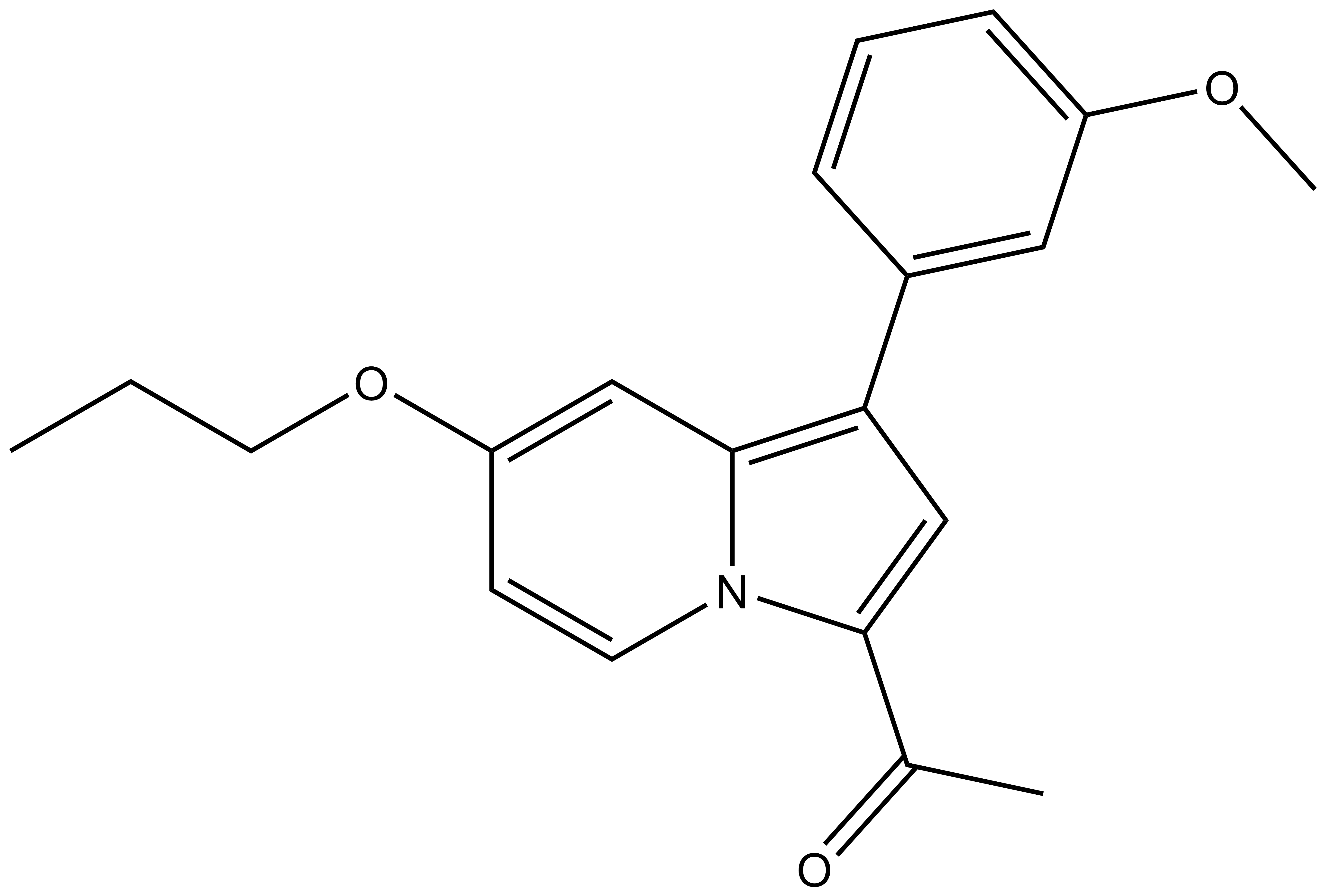 |
| 1-(1-(3-methoxyphenyl)-7-propoxyindolizin-3-yl)ethan-1-one For SDF click here |
| Physical and chemical properties | |
|---|---|
| Molecular weight | 323.39 |
| Molecular formula | C20H21NO3 |
| IUPAC name | 1-(1-(3-methoxyphenyl)-7-propoxyindolizin-3-yl)ethan-1-one |
| logP | 3.10 |
| PSA | 38.77 |
| No. of chiral centres | 0 |
| No. of rotatable bonds | 6 |
| No. of hydrogen bond acceptors | 4 |
| No. of hydrogen bond donors | 0 |
| Storage | Stable as solid in the dark at -20°C. NB making aliquots rather than freeze-thawing is recommended |
| Solubility | Soluble in DMSA at least up to to 50uM |
Potency against Target
GSK2801 has been shown by ITC to bind to BAZ2A with a KD of 257 nM and to BAZ2B with a KD of 136 nM. The ΔH for binding to BAZ2B is -10.69 (+/- 0.07) kcal/mol.
Selectivity Within Target family
GSK2801 showed significant thermal shifts of 4.1 and 2.7 °C for BAZ2A and BAZ2B respectively. GSK2801 did not show significant thermal shifts against all other bromodomains, except for BRD9 (ΔTm: 2.9 °C) and TAF1L (ΔTm: 3.4 °C) was observed. The KD of GSK2801 binding to BRD9 and TAF1L were determined to be 1.2 and 3.2 μM respectively by ITC.
Because of the limited sensitivity of BAZ2A/B in the thermal stability assay, the selectivity of GSK2801 was measured by BLI. Forty-two bromodomains modified with a Bir A biotin ligase targeting sequence were co-expressed in bacteria with the enzyme. The biotinylated proteins were used in BLI experiments probing the interaction of GSK2801 at two concentrations (0.2 and 1.0 μM). In agreement with the ΔTm data, BRD9 and TAF1(L) were detected as the major off-targets, while no other significant interactions were detected within the bromodomain family.
The structurally related GSK8573 proved to be inactive against BAZ2A/B and all other bromodomains except BRD9 in the BLI assay
Selectivity Beyond Target Family
GSK2801 (10 µM) was screened in a binding assay against 55 receptors and ion channels and was found to be inactive against all but the Melatonin (MT-1) receptor where inhibition was 4% of the control.
FRAP
To investigate whether GSK2801 can displace BAZ2 bromodomains from chromatin in living cells, we performed a fluorescence recovery after photobleaching (FRAP) assay utilizing GFP-tagged BAZ2A full length protein transfected into human osteosarcoma cells (U2OS). Mutant BAZ2A (N1873F) was used as a control that does not bind acetylated lysine containing peptides and therefore mirrors the behavi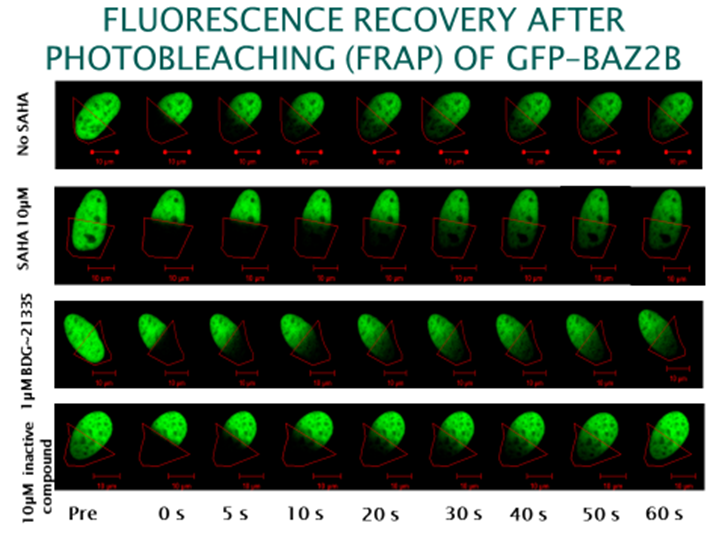 our of inhibitor bound BAZ2A. The histone deacetylase (HDAC) inhibitor suberoylanilide hydroxamic acid (SAHA) was used to increase overall levels of histone acetylation, resulting in a sufficient assay window to enable the measurement of differences in recovery time and demonstrating the acetylation dependence of the FRAP experiments. GSK2801 at 1 μM GSK2801 accelerated FRAP half-recovery time to the same extent as observed for the mutant construct indicating that the compound was able to displace BAZ2A from chromatin. Conversely, the inactive GSK-8573 did not have any effect on the half-recovery time of GFP-BAZ2A
our of inhibitor bound BAZ2A. The histone deacetylase (HDAC) inhibitor suberoylanilide hydroxamic acid (SAHA) was used to increase overall levels of histone acetylation, resulting in a sufficient assay window to enable the measurement of differences in recovery time and demonstrating the acetylation dependence of the FRAP experiments. GSK2801 at 1 μM GSK2801 accelerated FRAP half-recovery time to the same extent as observed for the mutant construct indicating that the compound was able to displace BAZ2A from chromatin. Conversely, the inactive GSK-8573 did not have any effect on the half-recovery time of GFP-BAZ2A
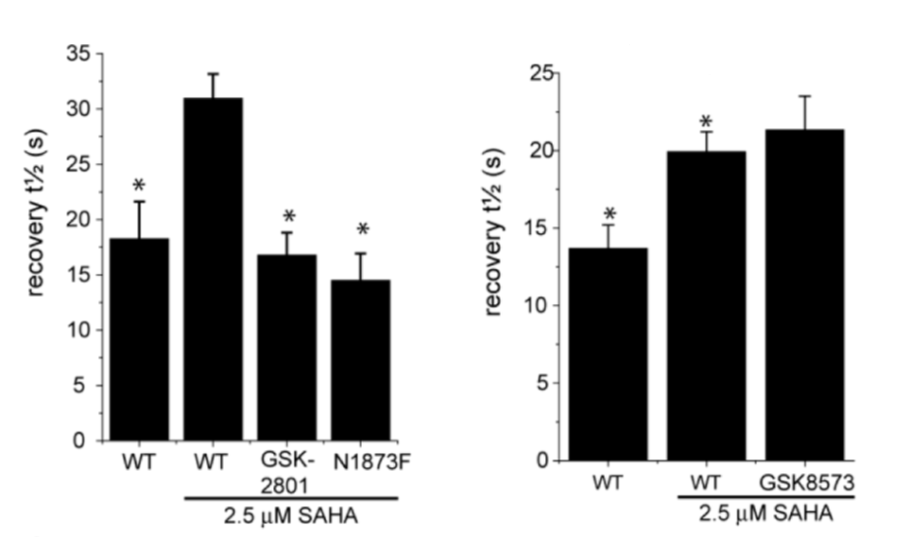
Cytotoxicity
GSK2801 showed no significant toxicity against U02S or HeLa cells
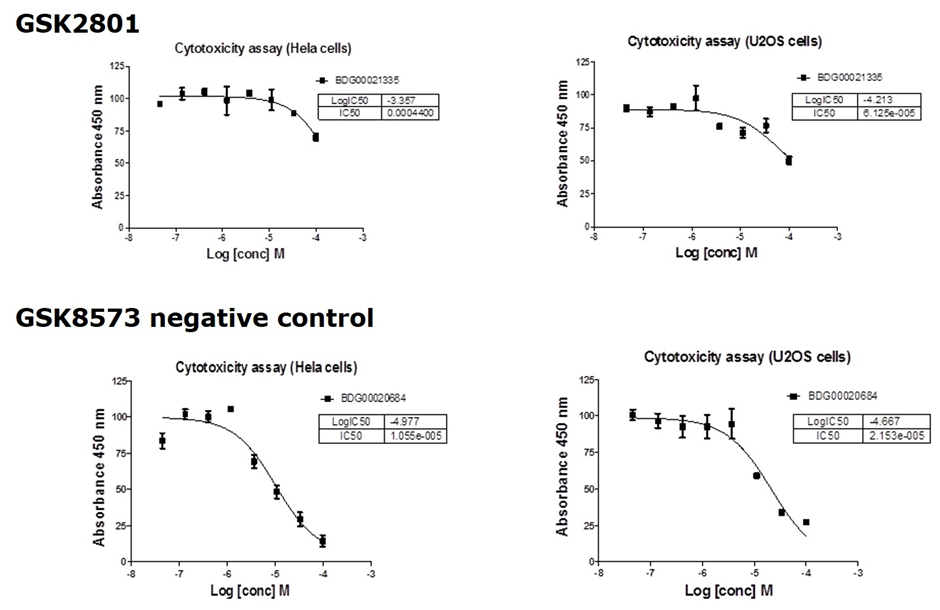
A Novel Family of Bromodomain Genes,
Jones, M. H.; Hamana, N.; Nezu, Ji.; Shimane, M., Genomics, 63, 40– 45 (2000)
Arking, D. E.; Junttila, M. J.; Goyette, P.; Huertas-Vazquez, A.; Eijgelsheim, M.; Blom, M. T.; Newton-Cheh, C.; Reinier, K.; Teodorescu, C.; Uy-Evanado, A.; Carter-Monroe, N.; Kaikkonen, K. S.; Kortelainen, M. L.; Boucher, G.; Lagace, C.; Moes, A.; Zhao, X.; Kolodgie, F.; Rivadeneira, F.; Hofman, A.; Witteman, J. C.; Uitterlinden, A. G.; Marsman, R. F.; Pazoki, R.; Bardai, A.; Koster, R. W.; Dehghan, A.; Hwang, S. J.; Bhatnagar, P.; Post, W.; Hilton, G.; Prineas, R. J.; Li, M.; Kottgen, A.; Ehret, G.; Boerwinkle, E.; Coresh, J.; Kao, W. H.; Psaty, B. M.; Tomaselli, G. F.; Sotoodehnia, N.; Siscovick, D. S.; Burke, G. L.; Marban, E.; Spooner, P. M.; Cupples, L. A.; Jui, J.; Gunson, K.; Kesaniemi, Y. A.; Wilde, A. A.; Tardif, J. C.; O’Donnell, C. J.; Bezzina, C. R.; Virmani, R.; Stricker, B. H.; Tan, H. L.; Albert, C. M.; Chakravarti, A.; Rioux, J. D.; Huikuri, H. V.; Chugh, S. S., PLoS Genet., 7, e1002158 (2011)
Guetg, C.; Lienemann, P.; Sirri, V.; Grummt, I.; Hernandez‐Verdun, D.; Hottiger, M.O.; Fussenegger, M.; Santoro, R., The NoRC complex mediates the heterochromatin formation and stability of silent rRNA genes and centromeric repeats, Embo J., 29, 2135-2146, (2010)
The pharmacokinetic parameters GSK2801 for in vivo experiments were measured after intraperitoneal and oral dosing in male CD1 mice. This PK study showed that GSK2801 has reasonable in vivo exposure after oral dosing, modest clearance, and reasonable plasma stability. These properties should allow GSK2801 to be used as a BAZ2A/B bromodomain inhibitor in vivo.
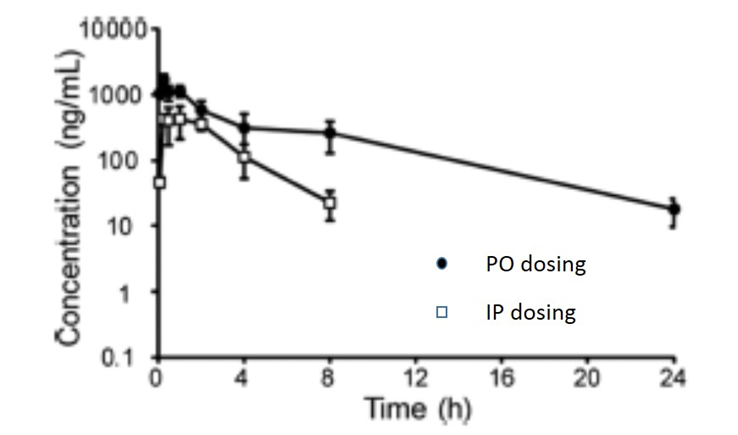
| IP 30 mg/kg | PO 30 mg/kg | |
| Tmax (h) | 0.25 | 1.0 |
| Cmax (ng/mL) | 1670 | 435 |
| Terminal t½ (h) | 4.5 | 1.5 |
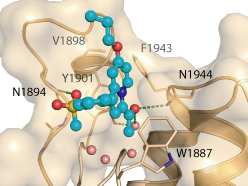
The co-crystal structure of GSK2801 and BAZ2B has been solved (pdb id: 4RVR).
Isothermal Titration Calorimetry
Experiments were carried out on a VP-ITC titration microcalorimeter from MicroCalTM, LLC (Northampton, MA), at 15 °C while stirring at 295 rpm, in ITC buffer (50 mM HEPES, 150 mM NaCl). All titrations were conducted using an initial injection of 2 µl followed by 34 identical injections of 8 µl with a duration of 16 sec/injection and a spacing of 250 sec between injections. The heat of dilution was determined by independent titrations (protein into buffer) and was subtracted from the experimental data. MicroCalTM Origin software was used to calculate enthalpies of binding (ΔH) and binding constants (KB). Thermodynamic parameters were calculated (ΔG = ΔH - TΔS = -RTlnKB, where ΔG, ΔH and ΔS are the changes in free energy, enthalpy and entropy of binding respectively). In all cases a single binding site model was employed.
Differential Scanning Fluorimetry (DSF)
Thermal melting experiments were carried out using an Mx3005p Real Time PCR machine (Stratagene). Proteins were buffered (10 mM HEPES, 500 mM NaCl) and assayed at a final concentration of 2 µM. Compounds were added at a final concentration of 10 µM. SYPRO Orange (Molecular Probes) was added as a fluorescence probe at a dilution of 1:1000. Excitation and emission filters were set to 465 nm and 590 nm respectively. The temperature was raised with a step of 3 °C per minute from 25 °C to 96 °C and fluorescence readings were taken at each interval. Data was analysed as previously reported [6]
Biolayer interference assays
BAZ2A and BAZ2B were expressed in frame with a C-terminal Avi tag and a His-TEV tag enabling enzymatic conjugation of a single biotin using the biotin ligase (BirA) which had been co-expressed in E. coli. Cells grown in the presence of 0.1 mM biotin were lysed and purified using a similar procedure. Incorporation of biotin was confirmed by ESI-MS spectroscopy. The biotin labelled BAZ2B and BAZ2A was immobilized on SuperStreptavidin BLI sensors. BioLayer Interferometry (BLI) experiments were performed on a 16-channel ForteBio Octet RED384 instrument at 25°C (25 mM HEPES, pH 7.5, 0.05% Tween and 100 mM NaCl buffer). The reference sensors without attached bromodomain were used to subtract background binding to SuperStreptavidin sensors. Data were processed and analysed using ForteBio Analysis software.
CEREP assay
GSK2801 (10 µm) was screened against a panel of 55 ligand receptors, ion channels and transports using an established and widely utilized commercial assay platform (ExpresSProfile; CEREP, Paris, FRANCE).
Fluorescence Recovery After Photobleaching (FRAP) Assay
FRAP studies were performed using U20S cells expressing full-length BAZ2A or BRD4 protein fused with an N-terminal eGFP as previously described [4]. Six hours after transfection 2.5uM SAHA (to increase global histone acetylation) was added and GSK2801 was added 1 hour before imaging. Imaging was carried out 24 hours after transfection. Percent inhibition was calculated between the DMSO treated (0%) and N1873F expressing mutant (100%)
Cytotoxicity Assay
U20S cells were harvested from exponential phase cultures and plated in a 96-well opaque flat bottomed plates at a cell density of 3 x 103 cells/well (100uL). Compounds were dissolved in DMSO at 10 uM and serial dilutions performed. 5 uL of compound solution was added to each well and incubated for 24 or 72 hours at 37˚C in a humidified atmosphere containing CO2 (5%). 10 uL of WST-1 (Roche) was added and the plates returned to the incubator. Plates were read on a plate reader at 450 nm after 2 h for cells treated with GSK2801 for 24 h. Results plotted as % of DMSO control.
Pharmacokinetics
These PK studies were performed by Shanghai ChemPartner Co. Ltd. The IP and PO dosing solutions were prepared in 0.5% CMC+1% Tween 80. No clinical symptoms were observed during the entire in-life study. Male CD-1 mice, 28-32g were used (with free access to food and water). A dose of 30 mg/kg (10 mL/kg) was used via intraperitoneal injection (N=9) and for oral dosing 30 mg/kg (10 mL/kg) via gavage (N=9). The animals were restrained manually for blood collection and approx. 110 μL blood/time point was collected, centrifuged at 4°C (2000 g, 5min) to obtain plasma within 15 min after sample collection. Plasma samples were stored at -70℃ until analysis. An UPLC/MS-MS-002 (API-4000) was used for sample analysis, with Dexamethasone as internal standard. An aliquot of 20 μL sample was added with 200 μL ACN containing 50 ng/mL dexamethasone. The mixture was vortexed for 2 min and centrifuged at 14000 rpm for 5 min. An aliquot of 1 μL supernatant was injected for LC-MS/MS analysis.
Toronto, ON - Almost $2 million is being invested by the Bill & Melinda Gates Foundation to help fight major parasitic diseases of the developing world.
The SGC-CHDI open access patent-free partnership for Huntington’s disease research has been selected as a featured Innovator to present on November 17th at the 6th annual
On Friday August 22nd, 2014, sixteen members of SGC at University of Toronto completed the ALS Ice Bucket Challenge outside the MaRS building (video here). As part of the challenge, SGC's Director, Aled Edwards nominated Takeda's General Manager Tetsu Maruyama.
ChemNET trainees on their final day at SGC-Toronto (L to R): Zafar Qureshi, Venugopal R
The probe is available from Sigma and Cayman Chemical.
| Probe |
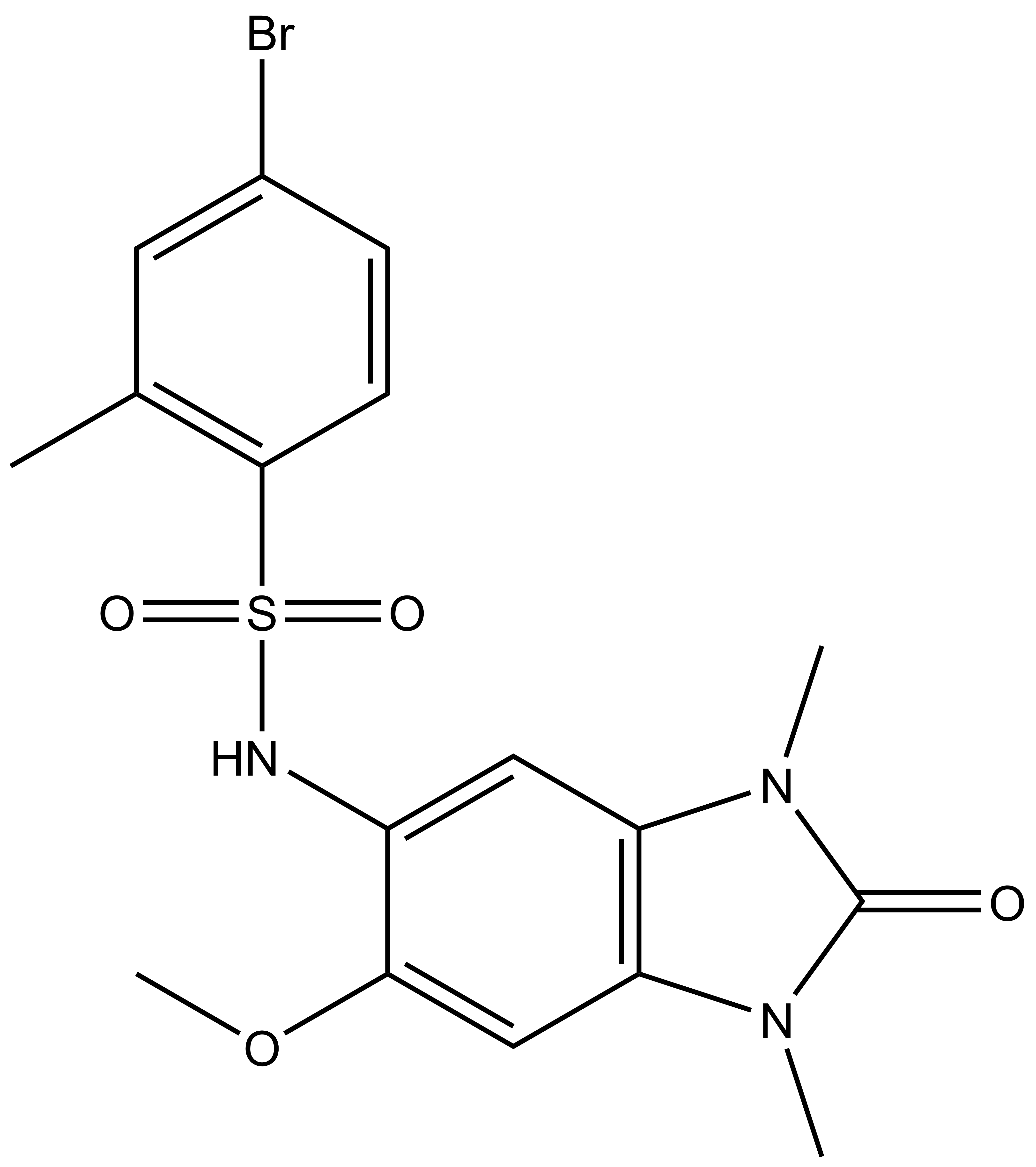 |
OF-1 |
A chemical probe for the bromodomains of the BRPF (BRomodomain and PHD Finger containing) family of proteins (BRPF1/2/3) has been discovered by the SGC.
BRPF1, BRPF2 (BRD1) and BRPF3 are scaffolding proteins, assembling HAT complexes of the MOZ/MORF family (MOZ, Ybf2/Sas3, Sas2, and Tip60) (1). These MYST complexes have a tetrameric core containing BRPF, the tumour suppressor ING and Eaf6/EPC (enhancer of polycomb)-related scaffold subunits. MYST complexes play crucial roles in DNA repair, recombination, and replication as well as in transcription activation (2,3). MOZ is frequently translocated in AML (acute myeloid leukemia) and is required for HSC proliferation (4).
Two BRPF1 isoforms (isoform A and B) can be generated by alternative splicing. In contrast to BRPF1B, the isoform A harbours a residue insertion in the ZA-loop that prevents binding to acetylated histone peptides (5).
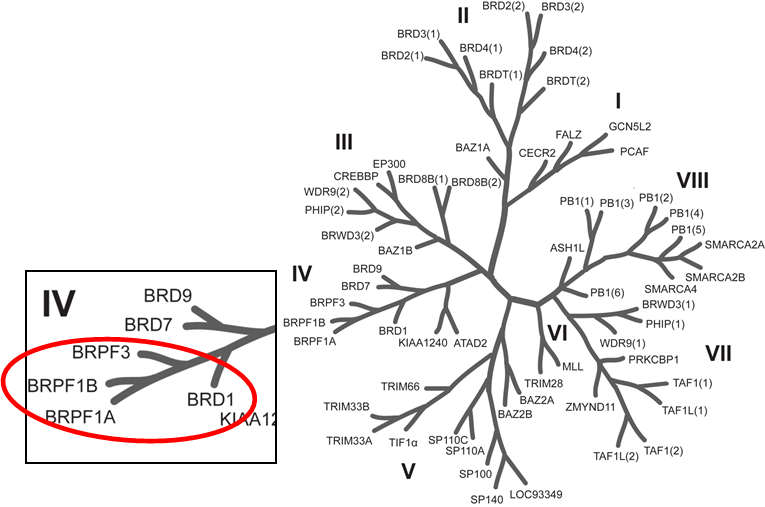
Phylogenetic tree of bromodomains and detailed view at the BRPF family.
OF-1 has been shown to bind to BRPF1B with a KD of 100 nM (ITC), to BRPF2 with a KD of 500 nM (ITC) and to BRPF3 with a KD of 2.4 µM (ITC). Selectivity against other BRDs is very good, in general >100-fold. The closest off-target effects are against BRD4 (39-fold selectivity) and TIF1α (50% inhibition at 20 µM in the alpha screen). OF-1 increases thermal stability in the cellular thermal shift assay (CETSA) of full length BRPF1B at 1 µM and also demonstrates accelerated FRAP recovery at 5 µM in the BRPF2 FRAP assay. It shows modest general cytotoxicity.
| Bromodomain | Kd/nM (ITC) | IC50/nM (Alpha Screen) | TM Shift °C |
|---|---|---|---|
| BRPF1B | 100 | 270 | 6.5±0.4 |
| BRPF2 (BRD1) | 500 | 2200 | 3.1±0.3 |
| BRPF3 | 2400 | ND | 3.3±0.2 |
| BRD4 (1) | 4000 | >10,000 | 2.0±0.2 |
OF-1 is a chemical probe with potent binding affinity for BRPF1 (KD of 100nM), BRPF2 (KD of 500 nM) and BRPF3 (KD of 2400 nM) as determined by isothermal titration calorimetry (ITC). Alpha screen biochemical assay confirmed OF-1 as a potent inhibitor of BRPF1 (IC50 of 270 nM).
OF-1 induced significant ΔTm shifts within the BRPF family. Weak interactions (2.1 °C) were also observed for BRD4(1), however alpha screen did not reveal strong interactions of OF-1 with BRD4 (IC50 of >10000 nM) and a KD of 4000nM for BRD4(1) reveals 39-fold selectivity when compared to BRPF1B isoform.
OF-1 shows no significant inhibition of protein kinases (<20% inhibition at 10 μM for 40 kinases screened).
We recommend to use the BRPF inhibitor NI-57 in parallel to confirm the result. Please do not apply OF-1 higher than 5 μM to avoid effects on BRD4 and verify the result by using NI-57.
OF-1 increases thermal stability in the CETSA of full length BRPF1B at 1 µM.
In a NanoBRETTM assay, BRPF1B, but not BRPF1A isoform shows dose-dependent displacement from histone H3.3, with IC50 of 0.08 μM and the FRAP assay reveals strong inhibition of BRPF2 (BRD1) at 5 µM concentration of OF-1.
OF-1 attenuates RANKL/MCSF induced differentiation of primary human monocytes into osteoclasts.
| Probe |
 |
OF-1 |
| Physical and chemical properties | |
|---|---|
| Molecular weight | 440.31 |
| Molecular formula | C17H18BrN3O4S |
| IUPAC name | 4-bromo-N-(6-methoxy-1,3-dimethyl-2-oxo-2,3-dihydro-1H-benzo[d]imidazol-5-yl)-2-methylbenzenesulfonamide |
| clogP | 2.55 |
| PSA | 78.95 |
| No. of chiral centres | 0 |
| No. of rotatable bonds | 4 |
| No. of hydrogen bond acceptors | 4 |
| No. of hydrogen bond donors | 1 |
| Storage | Stable as solid in the dark at -20°C. NB making aliquots rather than freeze-thawing is recommended |
| Dissolution | Soluble in DMSO |
Temperature Shift Assay
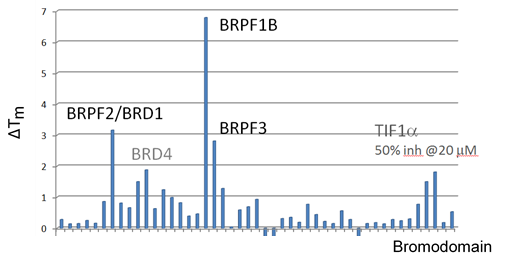
Selectivity screening of chemical probe OF-1 determined by temperature shift assay.
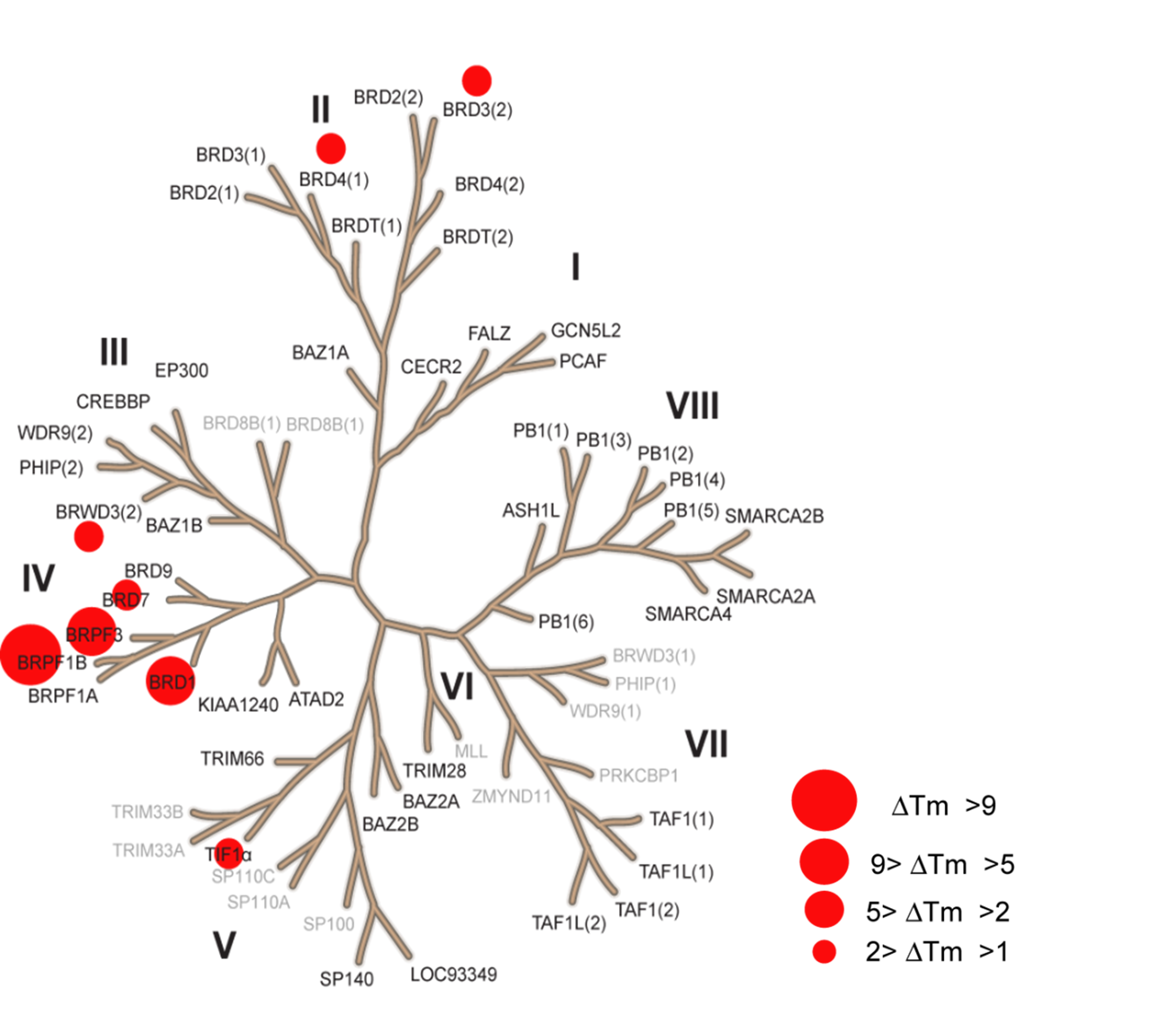
The temperature shifts mapped onto the phylogenetic tree using red circles corresponding to ΔTm as indicated in the figure.
CESTA
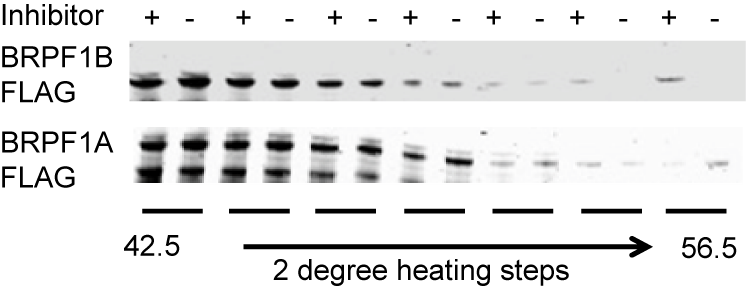
Thermal-stability of BRPF1A/B determined by CESTA at 1 µM OF-1.
NanoBRET
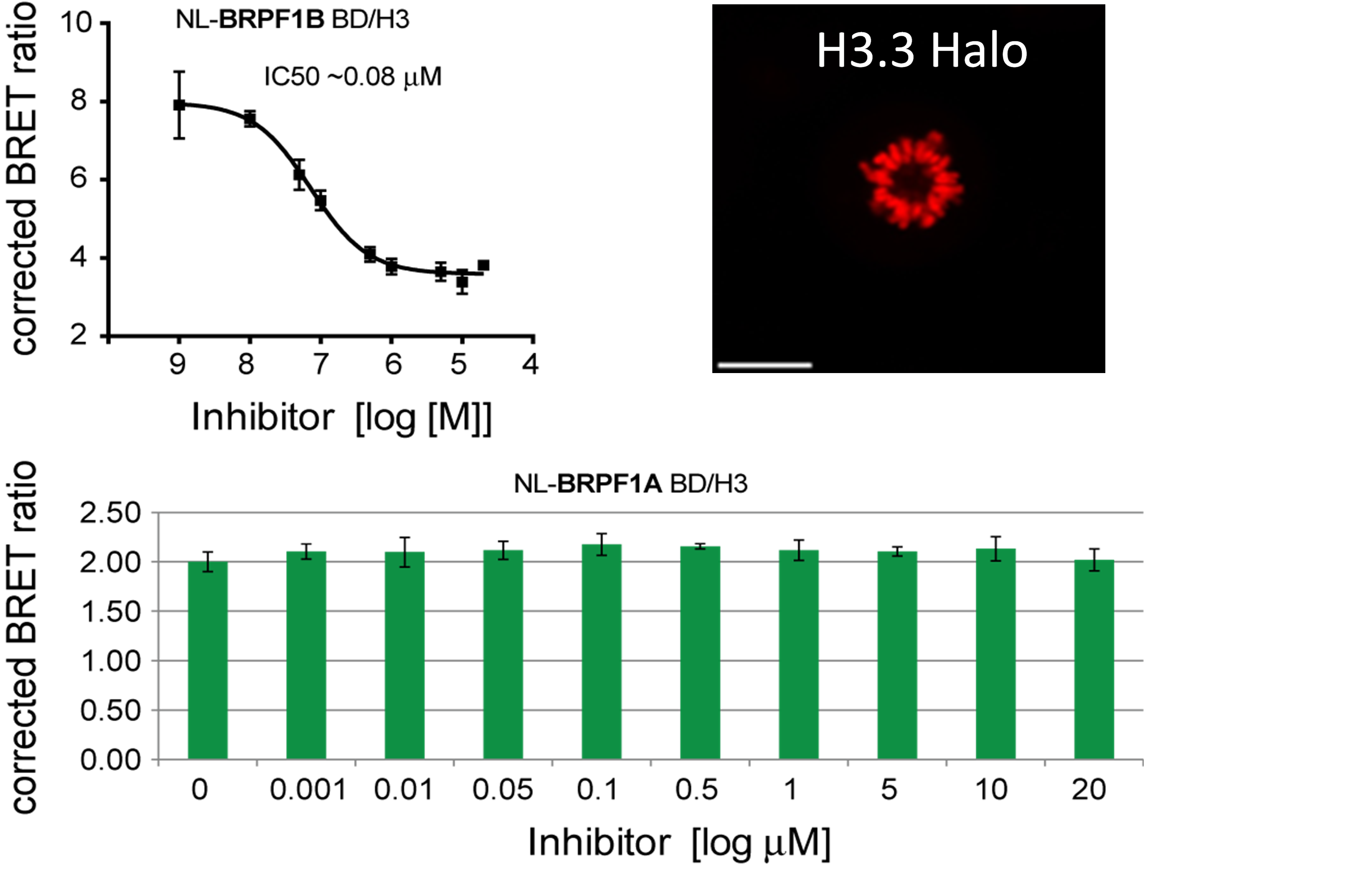
Dose-dependent displacement of BRPF1A/B from histone H3.3 following treatment with OF-1.
FRAP Assay
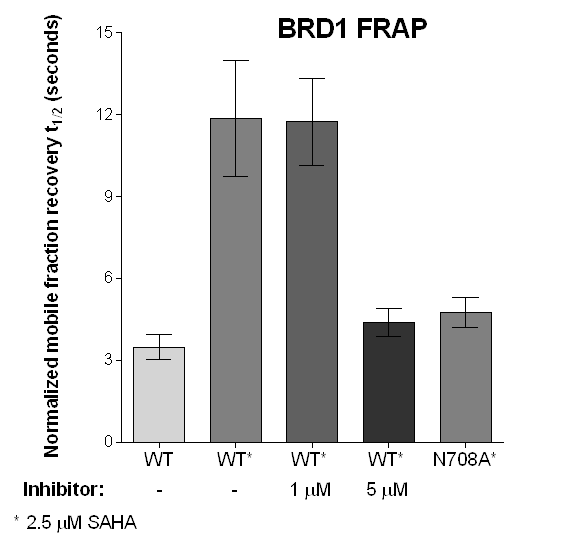
Half-times of fluorescence recovery (t1/2) after photo bleaching measured for BRPF2 (BRD1) after treatment with OF-1 at different concentrations with or without SAHA.
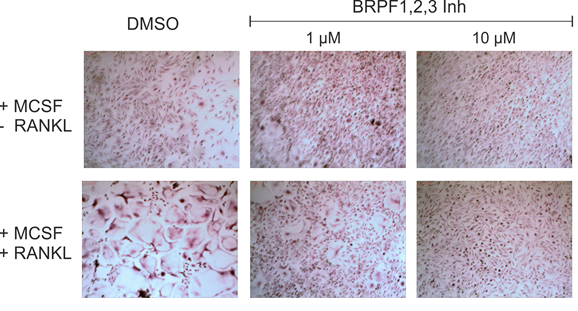
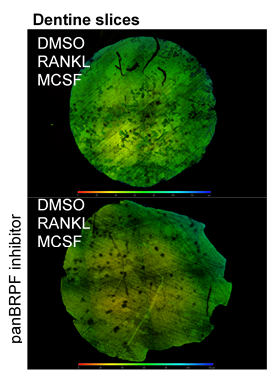
TRAP staining for osteoclasts and measurement of pits depth.
Work on this probe has been published in 'Selective targeting of Bromodomain-PHD fingers family (BRPF) bromodomains impairs osteoclast differentiation'.
Isothermal Titration Calorimetry (ITC)
All calorimetric experiments were performed on a VP-ITC micro-calorimeter (MicroCalTM, LLC Northampton, MA). Protein solutions were buffer exchanged by gel filtration or dialysis into buffer (20 mM Hepes pH 7.5, 150 mM NaCl, and 0.5 mM tris (2-carboxyethyl) phosphine (TCEP). All measurements were carried out at 288.15 K. All injections were performed using an initial injection of 2 µL followed by injections of 8 µL. The data were analysed with the MicroCal ORIGIN software package employing a single binding site model. The first data point was excluded from the analysis.
Temperature shift assay
Thermal melting experiments were carried out using a Stratagene Mx3005p Real Time PCR machine (Agilent Technologies). OF-1 was added at a final concentration of 10 µM. SYPRO Orange (Molecular Probes) was added as a fluorescence probe at a dilution of 1:1000 as described (6).
AlphaScreen Assay
Assays were performed as described previously with minor modifications (7). All reagents were diluted in 25 mM HEPES, 100 mM NaCl, 0.1 % BSA, pH 7.4 supplemented with 0.05 % CHAPS and allowed to equilibrate to room temperature prior to addition to plates. An 11-point 1:2.0 serial dilutions of the ligands was prepared on lowvolume 384-well plates (ProxiPlateTM-384 Plus, PerkinElmer, USA), using LabCyte Eco liquid handler. Plates filled with 5 µL of the assay buffer followed by 7 µL of biotinylated peptide [H-YSGRGKacGGKacGLGKacGGAKacRHRK(Biotin)-OH for BRD1, BRD4, BRPF1B and BRPF3 or YQTARKSTGGK(ac)APRKQLATKAK(biotin)-OH for TIF1α] and Histagged protein to achieve final assay concentrations of 25-100 nM depending on the dose-response curve for each individual protein. Plates were sealed and incubated for a further 30 minutes, before the addition of 8 µM of the mixture of streptavidin-coated donor beads (12.5 µg/mL) and nickel chelate acceptor beads (12.5 µg/mL) under low light conditions. Plates were foil-sealed to protect from light, incubated at room temperature for 60 minutes and read on a PHERAstar FS plate reader (BMG Labtech, Germany) using an AlphaScreen 680 excitation/570 emission filter set. IC50 values were calculated in Prism 5 (GraphPad Software, USA) after normalization against corresponding DMSO controls.
Fluorescence Recovery After Photobleaching (FRAP) Assay
FRAP studies were performed using U20S cells expressing full-length BRPF2 (BRD1). Six hours after transfection 2.5 µM SAHA (to increase global histone acetylation) was added and cells were treated with 1 µM or 5 µM of OF-1 1 hour before imaging and half recovery times from the fluorescence signal of the bleached U2OS nuclei were plotted.
NanoBRET
U2OS cells were co-transfected with Histone H3.3-HaloTag and NanoLuc-BRPF1. Twenty hours post-transfection cells were collected, washed with PBS, and exchanged into media containing phenol red-free DMEM and 4% FBS in the absence (control sample) or the presence (experimental sample) of 100 nM NanoBRET 618 fluorescent ligand (Promega). Cells were then treated with an increasing dose of OF-1. Five minutes prior to reading, NanoBRET furimazine substrate (Promega) was added to both control and experimental samples and plates were read on a CLARIOstar (BMG) equipped with 450/80 nm bandpass and 610 nm longpass filters with a 0.5 sec reading setting. A corrected BRET ratio was calculated and is defined as the ratio of the emission at 610 nm/450 nm for experimental samples (i.e. those treated with NanoBRET fluorescent ligand) subtracted by and the emission at 610 nm/450 nm for control samples (not treated with NanoBRET fluorescent ligand). BRET ratios are expressed as milliBRET units (mBU), where 1 mBU corresponds to the corrected BRET ratio multiplied by 1000. Relative IC50 values were estimated by non-linear regression analysis of (log) concentration of each inhibitor versus milliBRET ratios (GraphPad Prism).
Human osteoclast differentiation
Primary human peripheral blood mononuclear cells (PBMCs) were collected from a Histopaque generated buffy coat after gradient centrifugation at 20 min and 500g, brakes off. The CD14+ monocyte fraction was obtained by on-column CD14+-MACS bead isolation, washed twice with MACS buffer, and seeded at a density of 50 000 c/mL in αMEM/10%FCS supplemented with 25 ng/mL MCSF. After 6 days at 37 °C, 5% CO2 treatment with OF-1 with and without 50 ng/mL RANKL was started. Media were changed with fresh compound every 3−4 days. After 14−21 days, cells were fixed and stained for TRAP.
Bone Resorption Assays.
PBMCs were isolated and seeded onto self-cut dentine slices from ivory. After 14 days of differentiation, cells were removed from dentine slices. Dentine pits were imaged with confocal microscopy.
Toronto, Canada & New York City, USA — The Structural Genomics Consortium (SGC) and CHDI Foundation have entered into a unique open-access research collaboration to discover and characterize new drug targets for Huntington’s disease (HD) using structural and chemical biology.